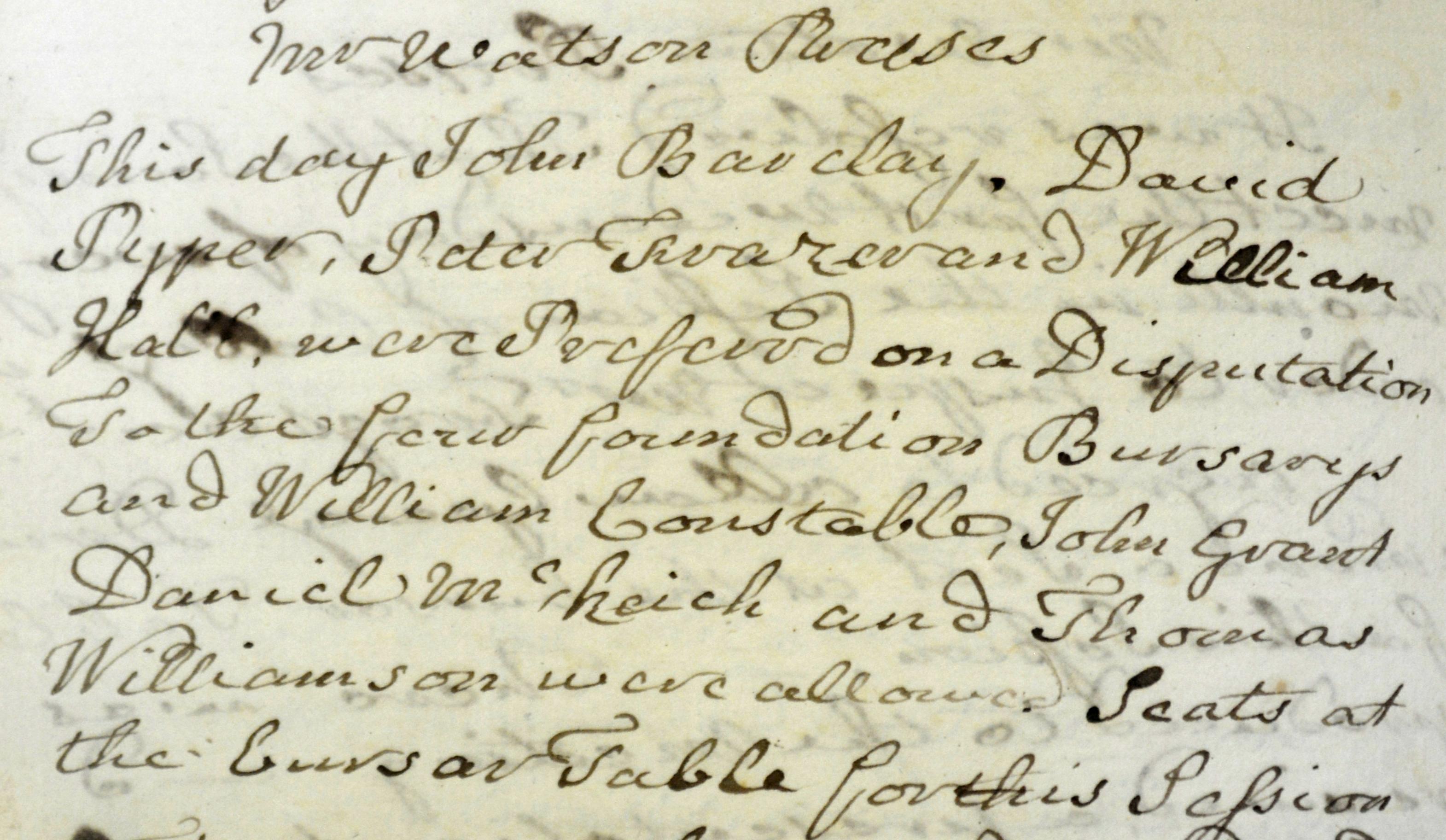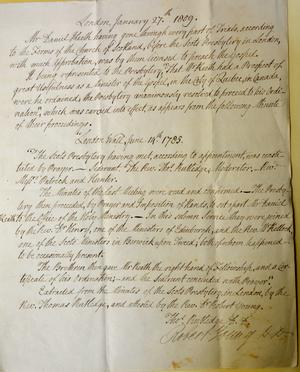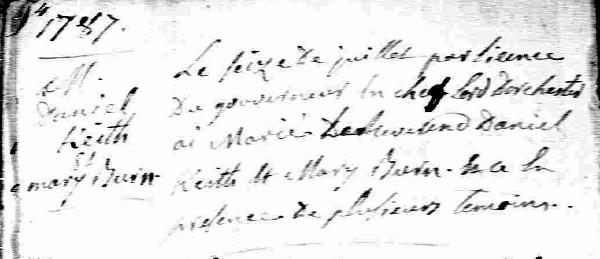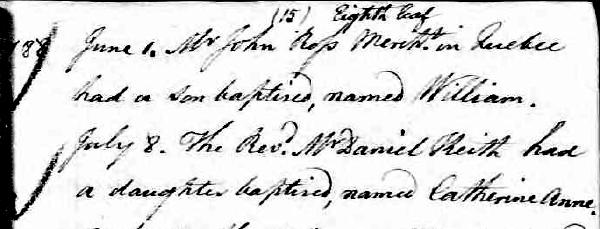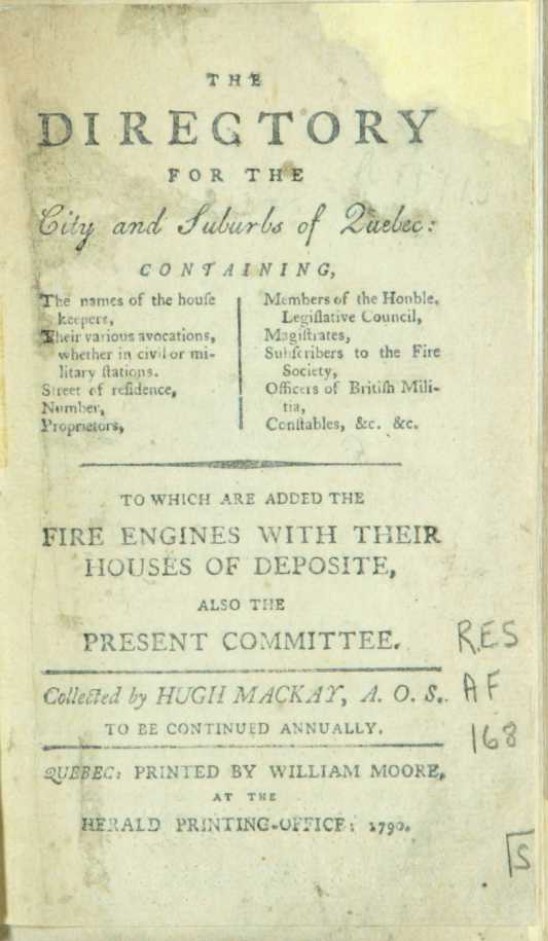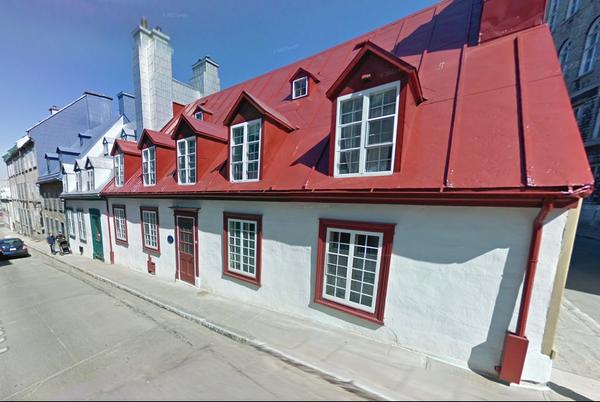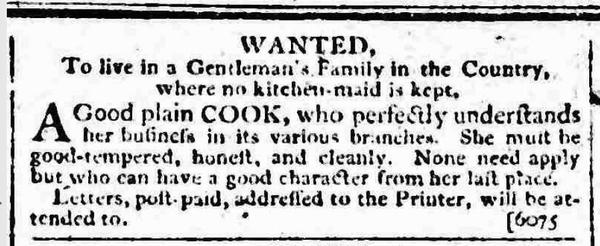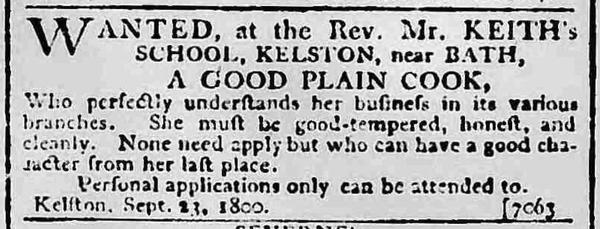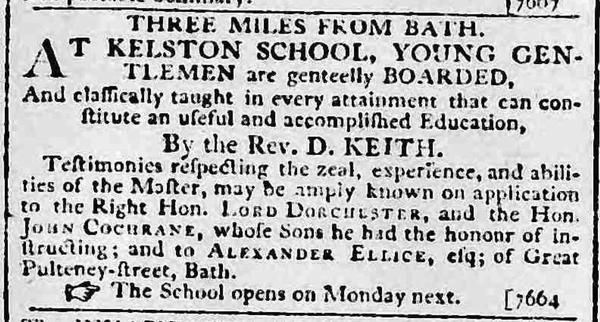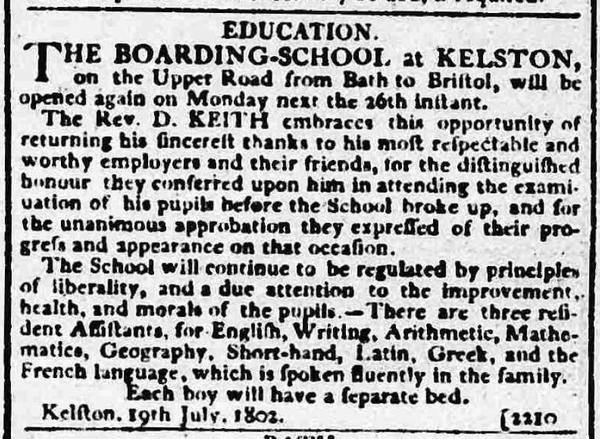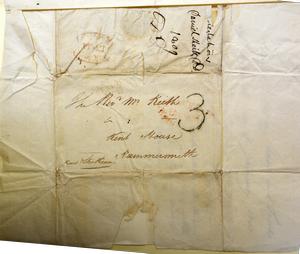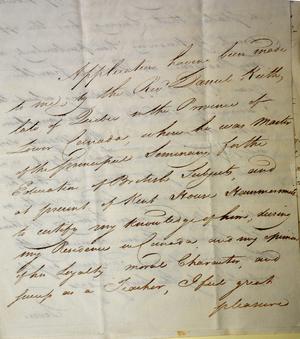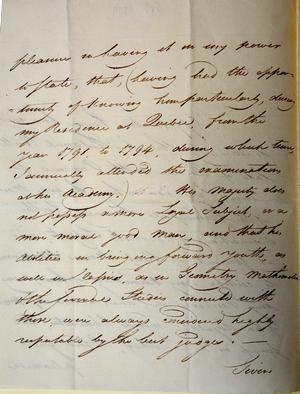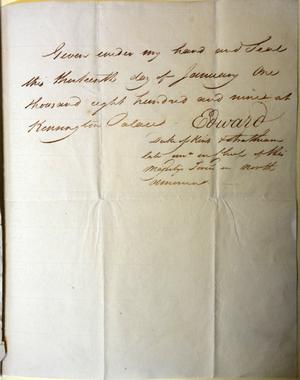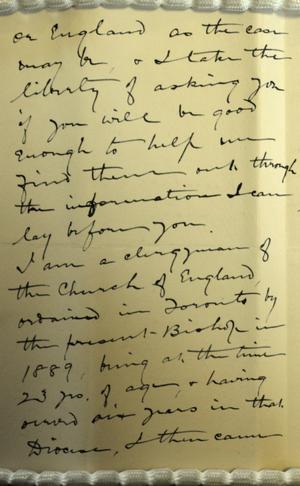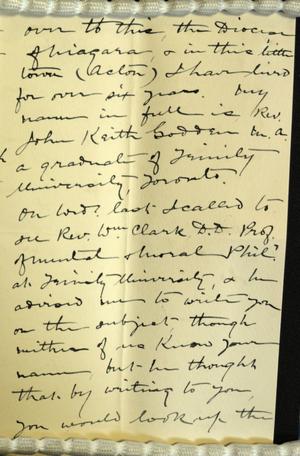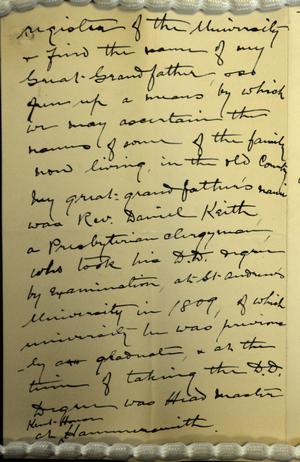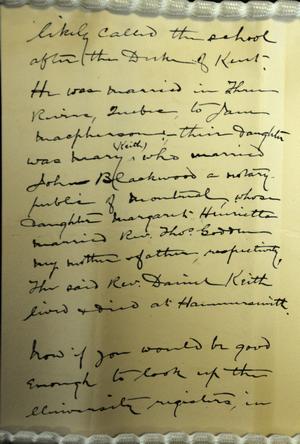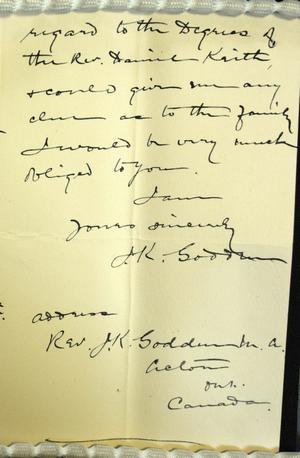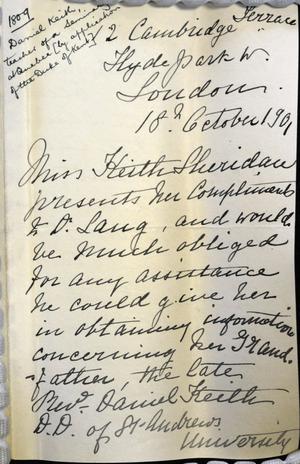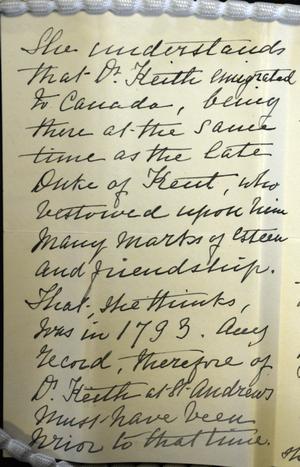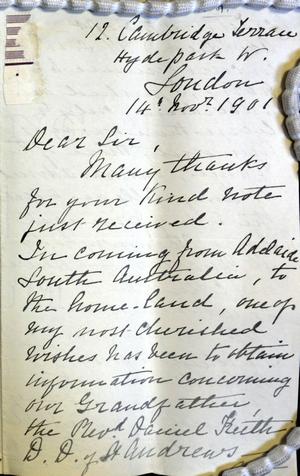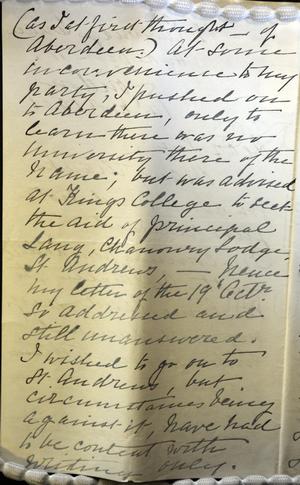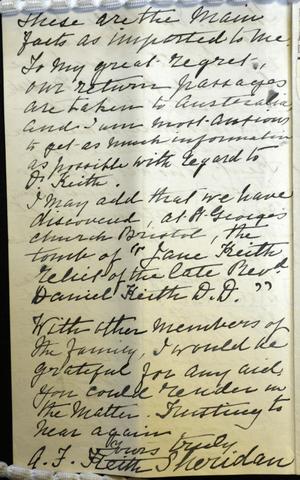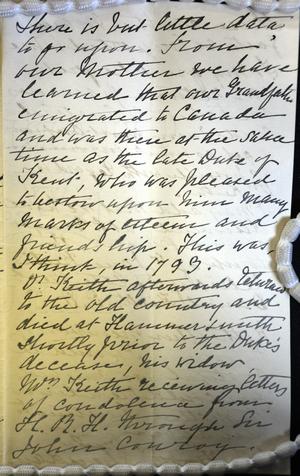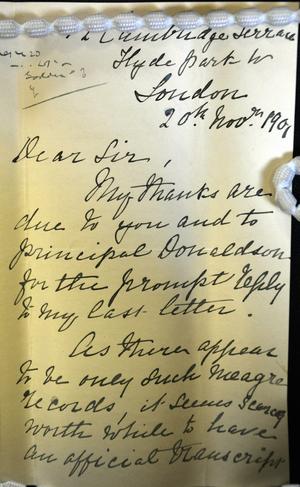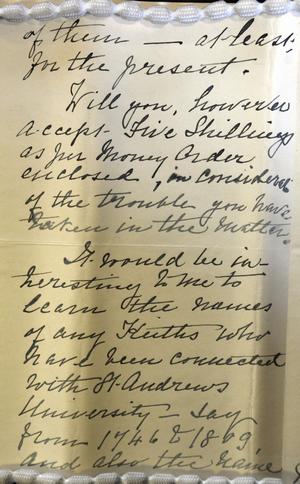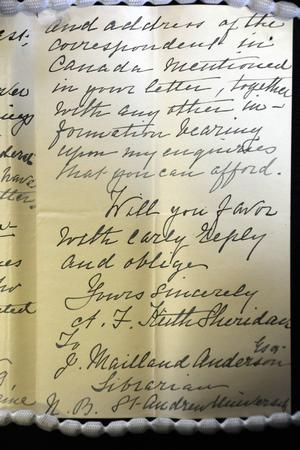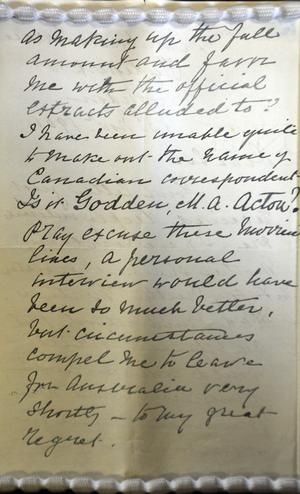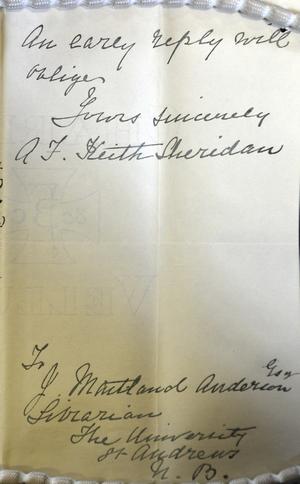The Reverend Doctor Daniel KEITH (1757-1811)
|
|||||||||||||||||||||||||||||||||||||||||||||||||||||||||||||||||||||||||||||||||||||||||||||||||||||||||||||||||||||||||||||||||||||||||||||||||||||||||||||||||||||||||||||||||||||||||||||||||||||||||||||||||||||||||||||||||||||||||||||||||||||||||||||||||||||||||
| You may use this search engine to look for a name or phrase within the Keith website. |
But we also provide a Table of Contents if you wish to jump forward in time.
Daniel KEITH Family Tree
To provide a context for this story we need to begin at the end, with the layout of Daniel KEITH's family, his parents and his ten children. You can go to the story of each person by selecting the hyperlinked name.
|
Daniel Keith's Early Years: From baptism at Monzie, Perthshire to being a scholar at St Andrew's University
We do not know for certain where and when Daniel was born or the names of his parents. We have not been able to locate a definite birth or baptism record for a Daniel KEITH in the Scottish records. Daniel was born around 1760 (he was recorded as age 51 years on his death in 1811) but the Scottish records, although extensive, are not complete for this time period. We can however, work backwards from the information we have to deduce who Daniel probably was and where he was baptised.
But first, what's in a name: Did Daniel McKIECH become Daniel KEITH?
The lack of evidence for a "Daniel KEITH" before about 1785 suggests either the records are missing or he changed his name. From the extensive evidence we do have we can deduce that the original family name was M'KIECH. The evidence lies in the records of St Andrews University.
- According to the records of St Andrews University, a Daniel KEITH was conferred with the degree of Doctor in Divinity on 4 February 1809, his application being supported by the Prince Edward, Duke of Kent and Strathearn (Queen Victoria's father).
- Why St Andrews? Other prestigious universities awarded this degree (Edinburgh for instance), but it would be usual practice for his alma mater to award the degree suggesting Daniel may have been a scholar at St Andrews.
- The St Andrews University archives hold documents relating to Daniel's application, with a note that he was "Said to have studied at St Andrews above 30 years ago, but not traced." (See University record here.)
- 30 years before 1809 would have placed Daniel as a student at St Andrews around 1775-1780.
- The St Andrews archives have a Daniel M'KIECH as a scholar 1775-1778 (see details here).
- At what age would a young man attend St Andrews? Daniel M'KIECH was a "ternar" (i.e. "the son of artisans and tenant farmers" who paid fees at one third of the top rate). He held bursaries and scholarships that would have paid his fees. If we assume Daniel was around 18-20 years old when he began at St Andrews, he would have been born around 1755-1757. His father would have been an "artisan" or tenant farmer, on a rural holding probably close to St Andrews in Perthshire (otherwise he might have gone to another university).
Daniel's signature
Another line of evidence related to Daniel McKIECH/KEITH lies in his handwriting. Handwriting can be distinctive and can identify a person throughout their life. We have examples of Daniel's signature from early in his life at St Andrews University and later at Quebec. Note how the capital letters D and K are very similar.
The evidence suggests Daniel M'KIECH changed his name to Daniel KEITH some time between 1779 (when he was studying at St Andrews) and 1785 (when he was ordained). Exactly when and why Daniel McKIECH became Daniel KEITH is not known. Perhaps KEITH was more socially acceptable, with its cachet to the KEITH clan.
Parish Records
Accepting that Daniel changed his name from M'KIECH to KEITH, we can look at the parish records for Scotland for this period. There is no trace of a baptism for a Daniel KEITH (acknowledging that the records may not be complete), but a Daniel McKIECH was baptised at Monzie, near Crieff, Perthshire on 4 December 1757 to John McKIECH and his wife Janet ROY. This date is consistent with Daniel's probable age as a student at St Andrews and his putative age at death in 1811. A brother to Daniel was baptised on 23 March 1760 also at Monzie. These are the only baptisms I can find for the children of John McKiech and his wife Janet.
 Baptism record for Daniel McKIECH at Monzie, Perth on 4 Dec 1757 |
 Baptism record for John McKIECH at Monzie, Perth on 23 Mar 1760 Note: these images are from Scotland's People |
The marriage of John McKiech and Janet is problematic. A John McKIECH married a Janet McLAREN at Monzie on 24 Sep 1756. The location and date would fit - but the surname differs. Perhaps the parish minister made an error, or perhaps Janet used her father's name on the marriage and her mother's name on the births?
Daniel M'KIECH's time at St Andrews University
Daniel arrived at United College, St Andrews University in late 1775, borrowing his first book from the university library on 27 November 1775. He matriculated (i.e. was formally enrolled as a scholar) on 15 February 1776, as recorded in the university's Matriculation Roll. Note that 21 scholars matriculated that year.
 1775-1776 Matriculation Roll for St Andrews University |
At that time the College was 30 years old, having been formed in 1747 by the amalgamation of the much older St Salvators and St Leonard's Colleges.
We visited St Andrews University in May 2019, having arranged with the archivist to view all documents relating to Daniel KEITH/M'KIECH. There were several packages. Photography of the documents was permitted but by hand-held camera only. I could not use a flash and I could not flatten out the documents, hence the images are not ideal, but can still be read.
- the University Minute Book that records Daniel M'Kiech's admission to United College as a "Ternar"(UYUC400:7.11.1775 - but note this refers to a "Donald" M'KIECH. The Donald is clearly an error when compared to later entries.
- his award of a seat at the Bursar's table in 1775 and 1776;
- His bursary lapsed in 1777
- the award of the Chancellor's "semiclass" term prize in 1777;
University Minute Book
These books are large, leather-bound tomes full of hand-written minutes. They are mostly in the same hand, apart from a few entries. There were 3 entries for Daniel McKeich (various spellings) on 7 Nov 1775 (page 760); 8 Nov 1776 (p798) and 10 Apr 1777 (p826). Two examples are shown here, the entry for the Chancellor prizes runs over two pages.
University Library book borrowing record
During his time at St Andrews, Daniel is recorded to have borrowed 23 books, the first on 27 Nov 1775. The last borrowing was returned on 9 May 1778. The titles cover a wide range of subjects, reflecting Daniel's studies and his interests. His borrowings are shown on two pages from the University's archives:
 Page 329 of the borrowers book, St Andrews University, showing Daniel McKIECH's borrowings for 1775 and early 1776. Images from the University of Stirling website "Books and Borrowing 1750-1830". |
 Page 42 of the borrowers book, St Andrews University, showing Daniel McKIECH's borrowings for 1776, 1777 and and early 1778. |
| Date Borrowed | Date returned | Title as recorded | Description of publication |
|---|---|---|---|
| 1775/11/27 | 1775/12/16 | Spectator 7. 8th V. | Published: Edinburgh. |
| 1775/11/27 | 1775/12/16 | Shakespear's Works 1 . 2d V. | Works of Shakespear. In which the beauties observed by Pope, Warburton, and Dodd, are pointed out. |
| 1776/1/6 | 1776/2/1 | Goldsmith's hist- Eng Vol 1st | The history of England, from the earliest times to the death of George II. |
| 1776/1/31 | 1776/2/9 | Do Vol 2d | The history of England, from the earliest times to the death of George II. |
| 1776/2/1 | 1776/2/6 | Spectator 1 . 2d Vol | Published: Edinburgh. |
| 1776/2/6 | 1776/2/19 | Adison's Works Vol 2d | The works of Joseph Addison. |
| 1776/2/10 | 1776/2/20 | Fool- of Quality 1 . 2d Vol | The fool of quality; or, the history of Henry Earl of Moreland. In four volumes. ... By Mr. Brooke. |
| 1776/2/19 | 1776/3/5 | Ditto 3. 4 Vol 5th | The fool of quality; or, the history of Henry Earl of Moreland. In four volumes. ... By Mr. Brooke. |
| 1776/3/12 | 1776/3/12 | Dych's Spelling-book | A Guide to the English Tongue. In Two Parts. The First proper for Beginners, shewing a Natural and easy Method to pronounce and express both Common Words, and Proper Names; |
| 1776/3/16 | 1776/4/4 | Goldsmith's Hist. 13. 24th Vol | The history of England, from the earliest times to the death of George II. |
| 1776/4/19 | 1776/5/3 | Goldsmith's Grecian hist. 1.2d V. | The grecian history, from the earliest state to the death of Alexander the Great. |
| 1776/11/4 | 1776/12/17 | Rol . Belles letter 1 . 2d V. | Method of teaching and studying the belles lettres, or an introduction to languages, poetry, rhetoric, history, moral philosophy, physicks, &c. |
| 1776/11/4 | 1776/11/27 | Adventurer 1 . 2d Vol | The adventurer. |
| 1776/11/27 | 1776/12/17 | Ditto .3. 4th Vol. | The adventurer. |
| 1776/12/17 | 1776/12/17 | Hume's hist- 2 . 5th Vol | History of England, from the invasion of Julius Caesar to the revolution in 1688. In eight volumes. |
| 1776/12/17 | 1776/12/21 | Addison's Works Vol 1st | The works of Joseph Addison. |
| 1776/12/21 | 1777/1/16 | Addison's Works Vol 3d | The works of Joseph Addison. |
| 1777/1/16 | 1777/1/16 | Bourk on the Sublime | A philosophical enquiry into the origin of our ideas of the sublime and beautiful |
| 1777/1/16 | 1777/1/16 | Blackwell on ye Classics | An introduction to the classics: containing, a short discourse on their excellencies; and directions how to study them to advantage: |
| 1777/1/23 | 1777/4/19 | Hume's Elementsof Crit.1 .2dV. | Elements of criticism. In three volumes. |
| 1777/11/27 | 1777/11/27 | Spectator 1. 7th Vol | Published: Edinburgh. |
| 1777/12/18 | 1777/12/18 | Xenophon's Expedition | Ξενοϕωντος κυρου Αναβασεω Βιβλια Επτα. Xenophontis de Cyri Expeditione (In Greek and Latin) |
| 1778/1/23 | 1778/5/9 | Hutchison Mor . phi. V 2d | A system of moral philosophy, in three books |
"The Spectator" was a publication focused on Einburgh and Scotland. It was first published in 1711 but was revived in about 1775. It continues today, publishing current affairs and opinion pieces.
 The Spectator 1776. One of the volumes borrowed by Daniel McKIECH. |
Ending his time at St Andrews
We note that Daniel's scholarship lapsed in 1777, but there is no record for the reason. Yet he continued at the university through to the end of term in May 1778. He had not completed his degree as he is not shown in the list of graduates. He may have left for financial reasons. He borrowings suggest an interest in teaching and he certainly spent the rest of his life in that endeavour. He was an ambitious person and he may have been offered an attractive role at a school either nearby or in a larger city such as Dundee or Aberdeen.
Ordination into the Church of Scotland Presbytery - 14 June 1785
The next definitive record we have for Daniel KEITH (now known by that surname) is a letter to St Andrews University from the Scots Presbytery in London dated 27 January 1809 containing a transcript of a Minute Book. This confirms that Daniel KEITH was ordained on 14 June 1785.
Importance of this Letter
This letter contains several important points.
- First it tells us that Daniel was in London in June 1785. The tone of the letter and the Minute suggest those present knew Daniel well and approved of his ordination, so he had probably been living in London for some time prior. It is unlikely he would have applied for ordination in a Presbytery where he was unknown.
- Second, to be ordained in this manner it would have been expected that Daniel had demonstrated the appropriate level of general education and competence in the Forms of the Church of Scotland. We know he had been a scholar at St Andrews University but do not know where he might have been working as a lay minister in order to learn the "Forms" of the church. Perhaps this also was in London?
- Third, the letter records "That Mr Keith had a Prospect of great Usefulness as a Minister of the Gospel, in the City of Quebec, in Canada". It appears that Daniel had already resolved to go to Quebec and his ordination was his final act before departure.
- Fourth, this information raises another point - on what basis did Daniel decide to go to Quebec? Quebec was still a French-dominated town, despite General Wolfe having beaten the French Army there a few years earlier. Its citizens were mostly French-speaking but there was a considerable Scots presence in the broader region. Certainly Presyterian ministers were rare and so too were good teachers for the english-speaking schools. There were risks in going, but perhaps Daniel also saw the prospects.
Eighteen days later he and Mr William Sarjeant boarded the sloop Ranger bound for Quebec and a new life as school teachers.
Daniel KEITH travels to Canada
Arrival in Quebec City
There is a shipping record for a Daniel KEITH arriving in New Brunswick in 1783 in the "Passenger and Immigration Lists Index, 1500s-1900s" edited by Filby but not enough detail to be sure this is our Daniel KEITH. The date is too early, unless Daniel returned to London to seek ordination (on 14 June 1785) before returning with the intention to start a school.
Daniel KEITH arrived in Quebec on the ship "Ranger" on 27 September 1785, in 56 days from London so departed London on 2 August 1785. (According to Lloyd's Register, the "Ranger" was a sloop of 300 tons, built in 1777 and registered in Stockton.) The passengers included a "Messr KEITH". On the basis of a newspaper advertisement (dated 11 October), this is the Rev. Daniel KEITH. Note there was also a Messr SERJANT (sic) on the ship, who had accompanied Daniel to Quebec.
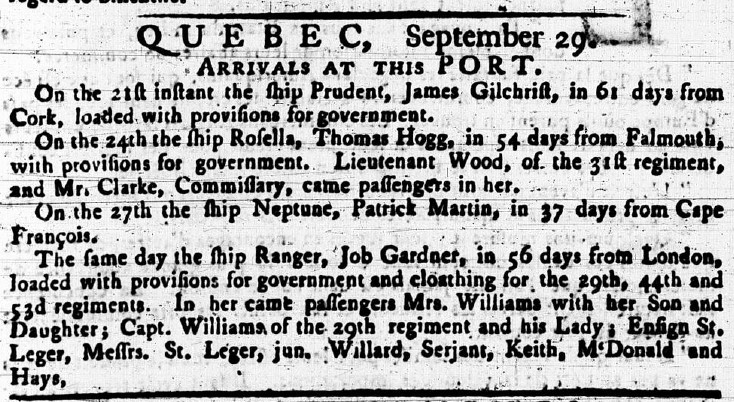 Quebec Gazette 29 September 1785. |
Setting up a school in Quebec
Just 2 weeks after their arrival, Daniel Keith and William Serjeant advertised in the Quebec Gazette that they were setting up a school, the notice dated 11 October 1785. The newspaper advertisement tells us several items of importance:
- that "several gentlemen in London ... advised us to settle in Quebec as teachers";
- Messrs Keith and Sarjeant had recently arrived;
- they propose to open a public school on 2 November;
- the location will be "at Madame La Croix's house on the top of the hill" (i.e. in Mountain St.), and
- the branches of education to be offered.
At the time of their arrival, Quebec City had a population of about 14,000 inhabitants (Statistics Canada estimate), about half being of non-French origin (mostly English and Scots). This population was growing but the number of school-age childen was small, and only males were catered for. Also there were separate schools for Protestant and French-speaking pupils. In 1790 there were five Protestant (English) schoolmasters. In 1792 there were only four schools with 160 pupils in total . William Serjeant's school (he had separated from Daniel Keith by this time) had closed in 1790, probably due to insufficient pupils.
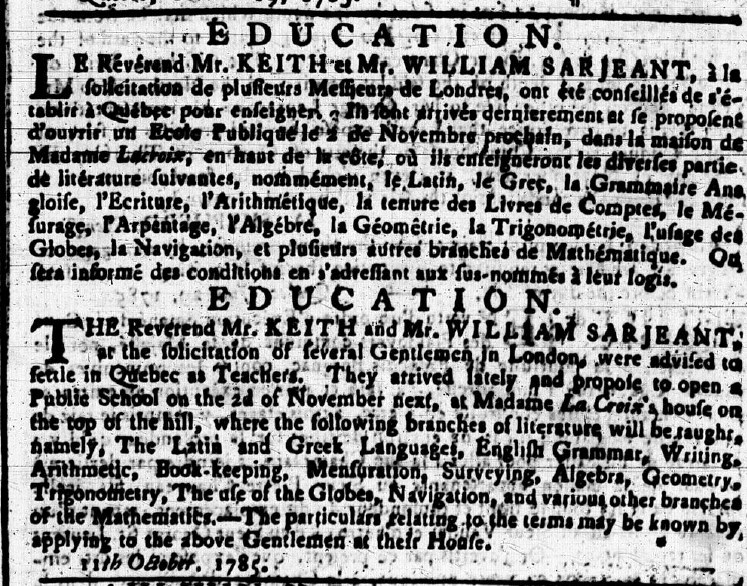 Quebec Gazette 27 October 1785. |
On 28 October 1785 the Lieutenant-Governor in the Province of Quebec (Hon. Henry Hamilton) concluded his term in the role and returned to London. On his departure he was presented with an Address, signed by many of the citizens of Quebec, including a "Dan KEITH", who had been in Quebec for just 4 weeks.
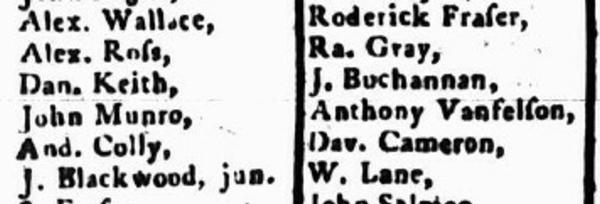 Quebec Gazette 3 November 1785. Click on image for full text. |
On 14 March 1786 Messrs. KEITH and SARJEANT advertised the opening of an evening school in Quebec. The location is not stated, suggesting locals would know where Messrs Keith and Serjeant lived.
 Quebec Gazette 16 March 1786. |
The first definite record we have for Reverend Daniel KEITH in Canada is a mention in the Quebec Gazette for 20 July 1786, when the house he currently occupied was put up for sale. The house was "on the top of the hill in Mountain St ... now occupied by the Revd. Mr KEITH". The vendor (Madam La Croix) considered it important to name the Revd. Keith as the occupant, suggesting Daniel was now well known about the town. Mountain St (now Côte de la Montagne) rises steeply from the waterfront, around the ramparts to join Rue Port Dauphin beside Montmorency Park. The park was created after the demolition of the "Bishop's Palace" - the last of several buildings on this site, that once housed Canada's parliament, and later that for Quebec Province. A later advertisement in the Quebec Gazette tells us the La Croix House was next to the Bishop's Palace.
 Quebec Gazette 20 July 1786. |
 Quebec Gazette 21 June 1787. This explains that even after sale, the la Croix house was still identifed with Revd. Daniel Keith.. |
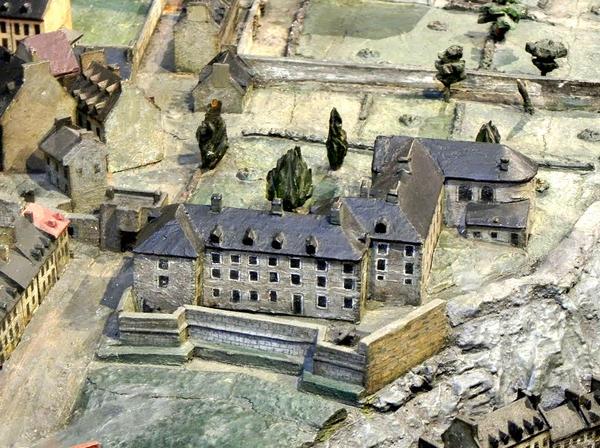 Part of the scale model of Quebec built in 1806 by the surveyor Jean Baptiste Duberger. Bishop's Palace in front, with Prescott Gate to the left across Côte de la Montagne (the gate was rebuilt in 1879 and 1984 and is now lower down Mountain St). The house occupied by Daniel Keith faced Mountain St and backed onto the ramparts so is probably the red house adjacent to the gate. |
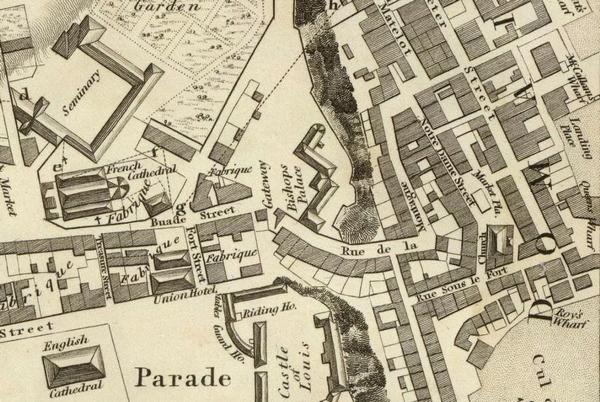 Part of the map of Quebec made by Joseph Bouchette and printed in 1815, showing the Bishop's Palace and Prescott gate. A full version of this map can be viewed here. |
By July 1787 Daniel was well-established as a schoolmaster in Quebec. He gave an address after one of his pupils had tragically drowned in the St Lawrence River, after falling out of a canoe. The incident occurred on Thursday 5 July; 11 days later Daniel was in Trois Rivières to marry Mary BURN.
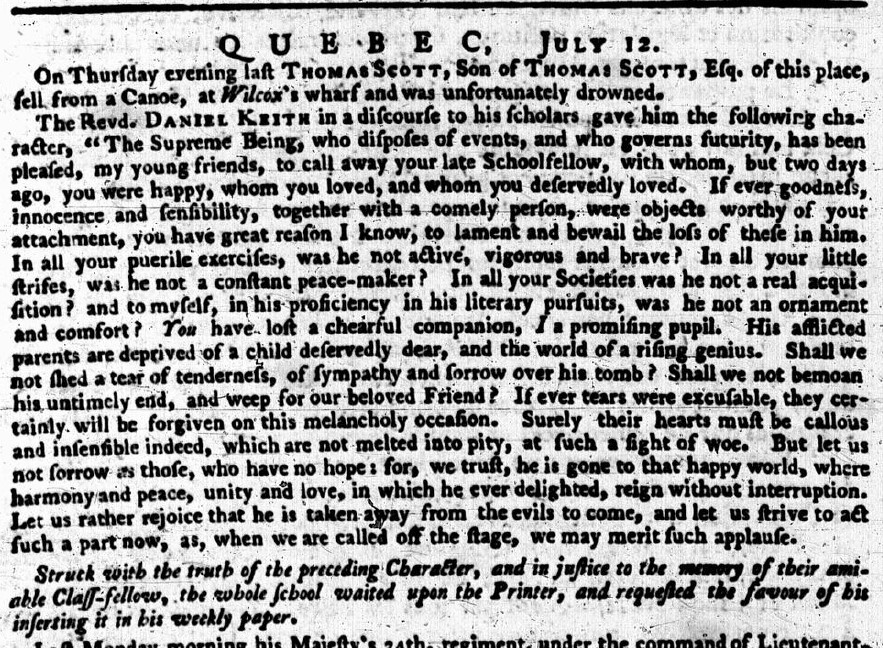 Quebec Gazette 12 July 1787. |
Marriage to Mary BURN
Although Daniel KEITH was living in Quebec he married Mary BURN on 16 July 1787 at the Protestant Church, Trois Rivières, Quebec, Canada. He was referred to as the Reverend Keith so we can be sure it the correct person. It is not clear that Daniel had ever lived in Trois Rivières, so how he met Mary is intriguing. We do know that a Selby BURNS (probably Mary's father) was a school teacher in Trois Rivières at this time, so they may have met through that connection. A year later on 8 July 1788 Daniel baptised his daughter Catherine Anne at the same church. The town of Trois Rivières (Three Rivers) is just west of Quebec, about half way between Quebec and Montreal. In the 1780s, Quebec had just become a British possession, having been wrestled off the French in the Battle of Quebec in December 1775. Trois Rivières would have been a small outpost settlement.
Deaths of Mary and Catherine
But this family was short-lived. His wife Mary died and was buried on 5 July 1788 at Trois Rivières. Two years later their daughter Catherine Anne died and was also buried at Trois Rivières, on 16 December 1790. Daniel, now aged only 30, had lost his wife and daughter. We are not sure why Mary and Catherine were buried in Trois Rivières, other than this being where her family lived. Daniel was living in Quebec during this time and we can assume that Mary and Catherine were living with him. After Mary died it is possible that Mary's family cared for Catherine until her death.
 |
 |
Records of schools and clergy in Quebec
In 1787 Lord Dorchester was considering the need for more support for schools and non-Catholic clergy in Quebec Province. He presented a list of clergy and schoolmasters, and the level of financial support they received. The following year the Quebec City Directory for 1788 lists Daniel as a Presbyterian Minister at Quebec.
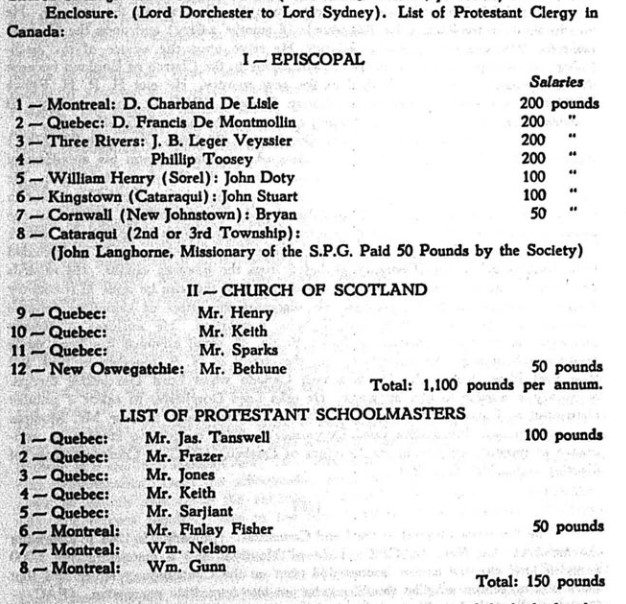 1787 letter to Lord Sydney. |
|
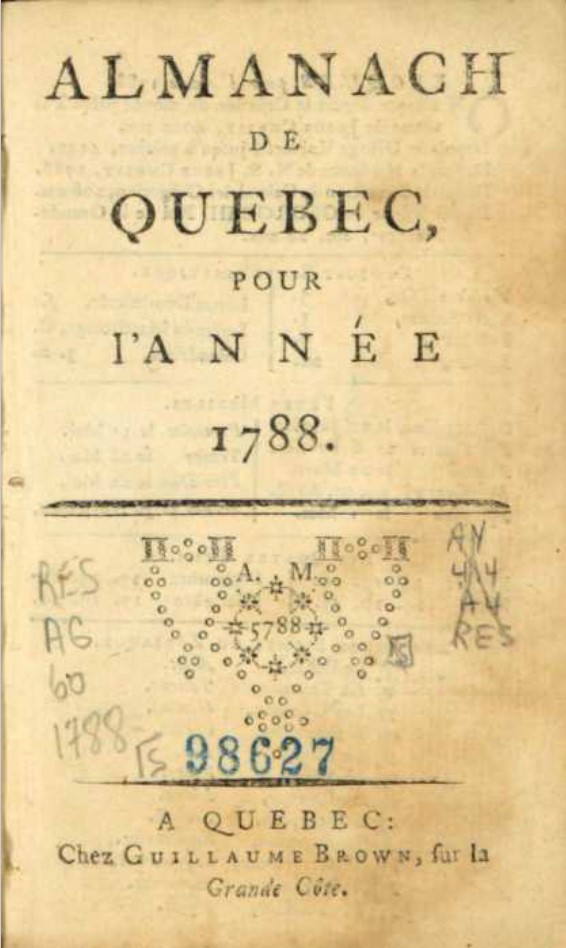 |
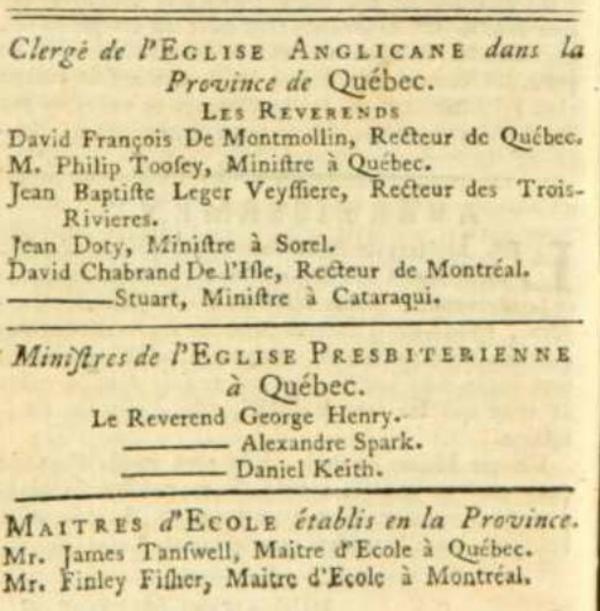 p. 30 of the 1788 directory. |
Visit to Daniel Keith's School by the Bishop of Nova Scotia
On 12 July 1789 The Bishop of Nova Scotia embarked on a tour of the Province of Quebec. While in Quebec City he visited Mr Keith's school, and recorded the event in his diary.
 Entry in the 1787 diary by the Bishop of Nova Scotia. |
 Footnote 4 of the diary entry. The 1787 reference is to the address Daniel gave on the death of a pupil. |
Notary Public files
Held at the Quebec Archives in Montreal are the files from early notary public solicitors in Quenbec City and Montreal. At the Archives is an index listing holdings by the name of the notary public, followed by the title of each document. Once the date and page are known the files are available on microfiche. Two of these files appear to relate to properties in Quebec. The other file runs over 14 pages.
On 1 February 1790 Daniel had signed the lease for a property in Quebec.
 Index of Notary Public files held by Charles VOYER, Quebec, file No. 344. |
||
 Notary Public file No. 344 dated 8 February 1790. The file can be downloaded in PDF format here. |
 |
 |
In 1791 Daniel was one of several signatories on this 14 page document.
 Index of Notary Public files held by Pierre-Louis Descheneaux, Quebec. |
||
 Notary Public file 2672 dated 7 Sept 1791. The file can be downloaded in PDF format here. |
 |
 |
 |
 |
 |
 |
 |
 |
 |
 |
 |
 |
 |
|
In 1793 Daniel signed this file.
 Index of Notary Public files held by Pierre-Louis Descheneaux, Quebec file 3059 |
||
 Notary Public file No. 3059 dated 20 July 1793. The file can be downloaded in PDF format here. |
 |
 |
Directories and other publications
The Directory for the City and Suburbs of Quebec published in 1790 has Rev. Daniel KEITH, Schoolmaster, at 13 St Famille St, Upper Town.
In October 1790 Daniel KEITH was one of many signatories to a Petition to the Governor-General of the Province of Quebec (Guy Lord Dorchester) asking for the establishment of a "University of the Province of Quebec". He signed as Daniel Keith, Protestant Minister.
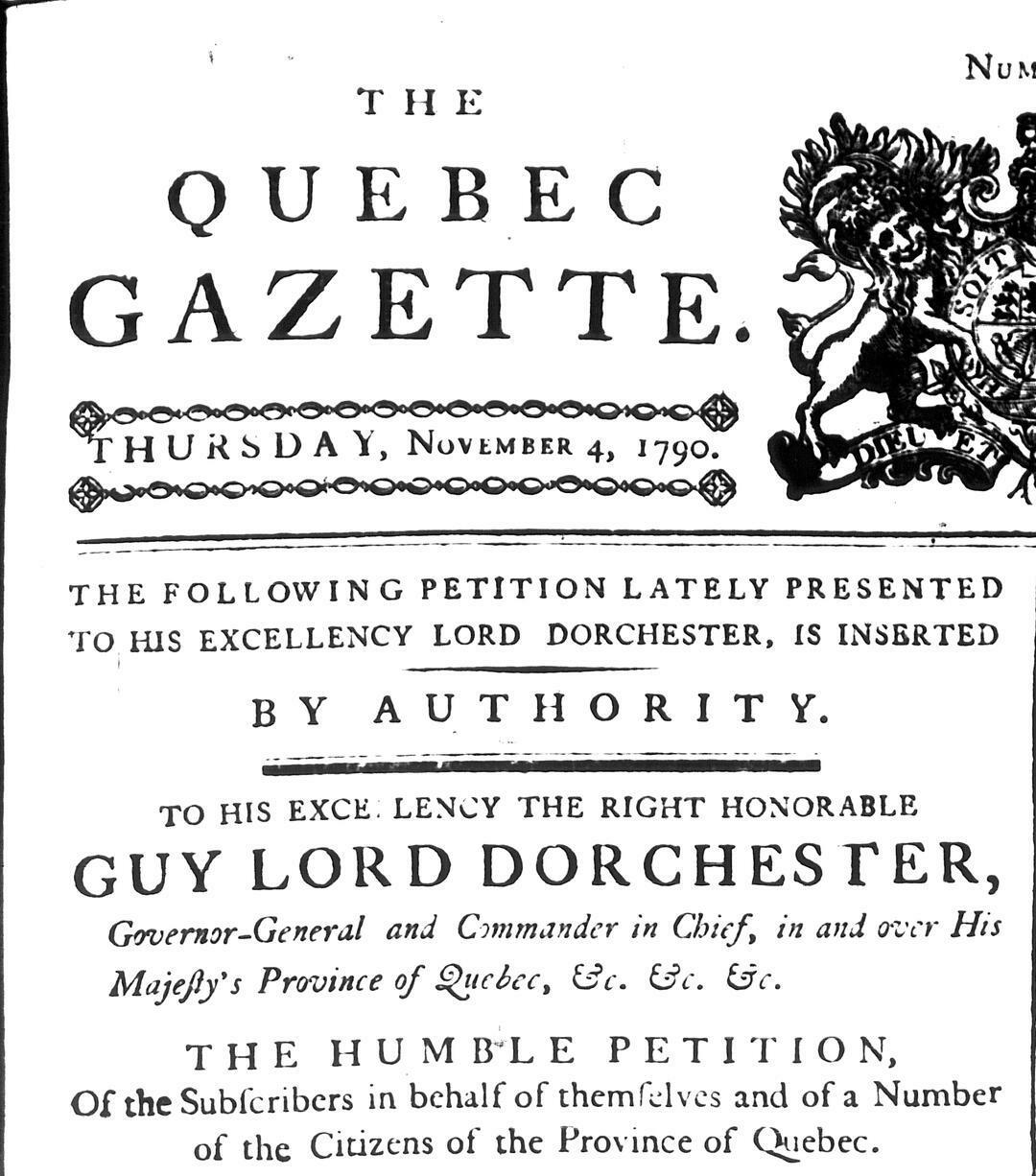 |
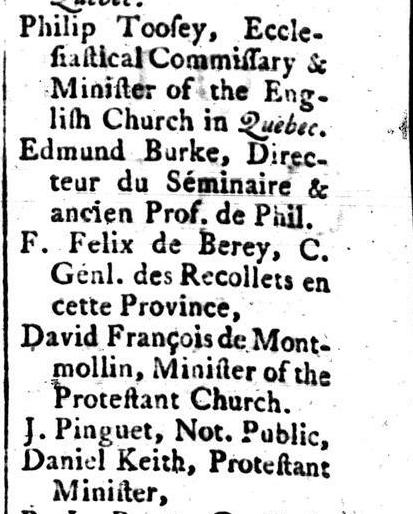 |
Daniel became well established as a school master in Quebec, one of eight in the town. By 1790 the school was at 13 Rue St Famille. By 1790 he appears to have separated from his former colleague: William Sergent was now running a separate school from the Bishop's Palace: in 1791 he had 11 pupils, but the school appears to have gone by 1792. By 1792 Daniel had 36 scholars. He did not receive funding from the government for this school. He was also a member of the Quebec Agricultural Society.
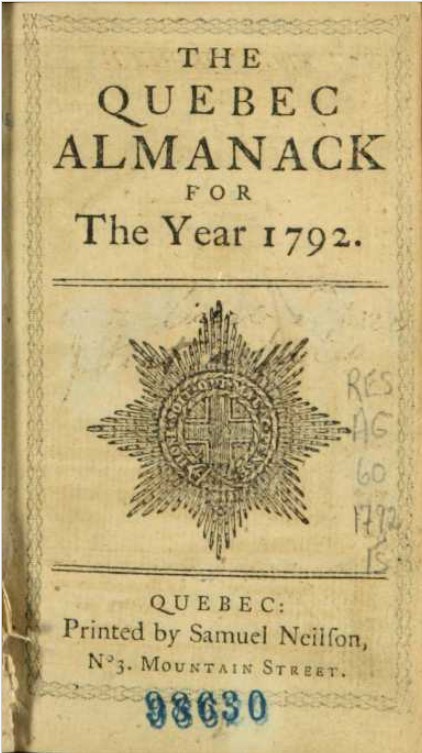 |
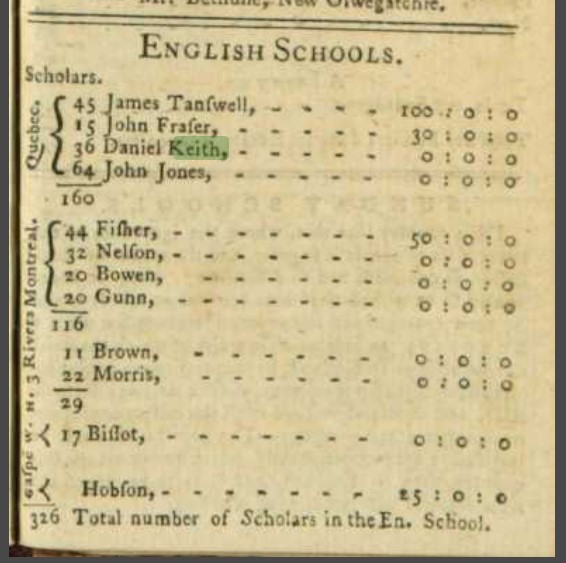 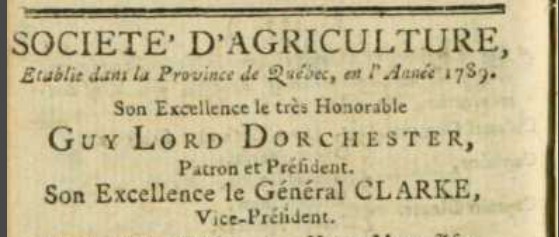  |
Daniel's school had become well known. In May 1791 his "Grammar School" was inspected by a large group of prominent officials and "a great number of respectable citizens" who were obviously impressed.
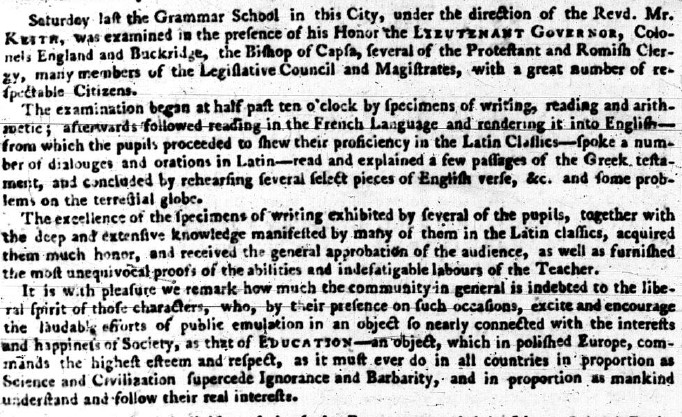 Quebec Gazette 26 May 1791. |
A Sermon for the Duke of Kent and a school inspection by His Majesty
On 22 June 1792 the Rev KEITH preached "a most excellent sermon" to a meeting of the ancient fraternity of Freemasons. In the audience was Prince Edward, fourth son of George III, later to become the Duke of Kent and Queen Victoria's father. On 27 March 1793, the Rev KEITH was in the procession, along with Prince Andrew, for the funeral of Mr Galloway, a baker in Quebec and a Freemason. The Duke clearly knew Daniel KEITH well so it is not surprising he maintained a keen interest in the fortunes of Daniel KEITH and his school in Quebec. Later, the Duke was the key sponsor when Daniel applied to St Andrew's University for the degree of Doctor in Divinity.
 Quebec Gazette 28 June 1792. |
 Quebec Gazette 8 August 1793. |
An inspection by the Lord Bishop of Quebec
In February 1795 the Bishop of Quebec and his Clergy called at Mr Keith's school and examined the youths under his tuition. They were much impressed.
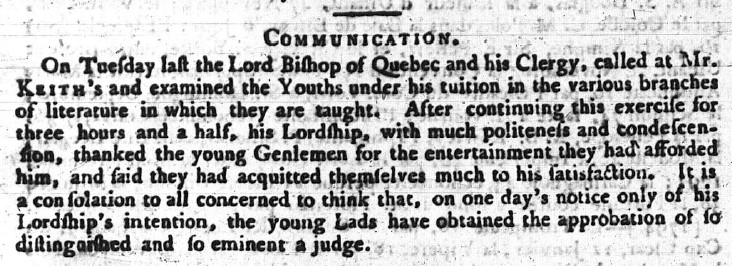 Quebec Gazette 19 February 1795. |
Marriage to Jane McPHERSON
Once again, Daniel travelled to Trois Rivières for marriage. He married Jane McPHERSON at the Trois Rivières Protestant Church on 17 October 1794. He was a widower aged 34 and she a spinster aged 18. On the marriage record Daniel was "of the parish of Quebec", confirming his residence there. It is possible that Daniel had met Jane during his visits to Trois Rivières when he married Mary BURN or for the funerals. If this was so then Jane was only aged 11 to 14 years at the time. The McPHERSON family plays an important role in the early history of Quebec. Jane's sister Anne also appears later in the KEITH story.
 |
Daniel and Jane KEITH's Family in Quebec
We do not know how many children Daniel and Jane had in Quebec, but the evidence suggests that Isabella was born in 1796 (she died in Hammersmith, London on 26 January 1811 aged 14) and Mary was born in about 1797. Neither child appears to have been baptised at Quebec (or at all). If the ages at death are close to correct then Isabella was older than Mary and as Mary gave her place of birth as Quebec in the 1901 census for Canada (see Mary's story here) then Isabella must also have been born in Quebec. The next child might have been Susan (probably born in Bristol), followed by Edward Joseph (born 1801 in Bristol, Somerset).
Departure: from Quebec to Bristol
On 23 March 1796 Daniel sold a property in Quebec to the Hon. John YOUNG. On 19 April 1796 (and again on 5 May) he advertised his house at 23 St Anne's St, Quebec, for sale. He indicated that he wished to retain possession of the lower floor (which presumably he used as the school room) from 1 May until 1 August. This suggests he had already decided to close the school and depart Quebec (and presumably Canada) by early August 1796; or he had found better premises for the school to start at the beginning of the next term. As he soon moved to Somerset, it is most likely that he closed the school.
 Index of Notary Public files held by Felix TÊTU, Quebec. |
 Quebec Gazette 21 April 1796, page 4. (Click on image for PDF of the Gazette.) |
Why did the Rev. Daniel KEITH leave QUEBEC?
We do not have any further information about Daniel KEITH and family in Canada after the 1796 newspaper advertisement. He may have left at that time, but the birth of daughter Mary (in Quebec) would have been in late 1796 at the earliest. Daniel KEITH does not appear again in the Quebec Gazette, nor in the Almanac for Quebec for 1797 or 1798, although he was listed in earlier editions as both a teacher in Quebec and as a Protestant Minister.
We will never know, but there are three obvious circumstances that would have influenced Daniel and his family. The first was the loss of his benefactor the Duke of Kent: the Duke moved from Quebec to Halifax, Nova Scotia in 1795. The second was economic: the school market in Quebec was not large enough, or with enough funding to support Daniel and his growing family. The third was security.
With about half the population in Quebec of French origin and with the French Revolution underway by 1789 (Louis XVI was executed on 21 January 1793), the English settlers in Quebec were rightly nervous. On 10 July 1794 the Quebec Gazette published a statement signed by many citizens - English and French - that exorted their fellow subjects to uphold the powers of the King, government and Constitution against "the seditious attempts lately made by wicked and designing men ... against the powers of our Government, and the laws". As the situation in France deteriorated further, Daniel KEITH may have decided that Quebec may no longer be safe for him and family.
In Daniel's mind may also have been the fragile state of his finances, that would have been made intolerable if the French revolution had spread to Quebec as some people were trying to engineer. In 1792 through to 1795, apart from the large French Séminaire de Québec with 110 pupils, in Quebec City there were four Protestant schools as well as two "pour les écoles francaises" and "une écoles pour les Sauvages" (from "Les Premiers Alamanachs Canadiens"). In 1796 a further school had been opened by an Alexander Clifford who later moved to Trois Rivières. Only two of the Protestant schools were funded by the government - Mr Tanswell received £100 for his 45 pupils and John Fraser received £30 for his 15 pupils. Daniel KEITH and John Jones received nothing: theirs were private schools relying solely on fees from the pupils. Messrs Tanswell and Fraser were receiving about £2 4 shillings per pupil per year but they charged fees as well, possibly another £2 or more per year. At this government rate Daniel's income on 36 pupils would have been about £80. As this was Great Britain Pounds, adjusting this for inflation from 1790 to 2024 and converting to Canadian Dollars gives $CAD17,000 - about half the minimum wage in Canada today. This suggests Daniel KEITH and other private schools may have had to charge about £5 per year, a lot of money to the early settlers in Quebec, despite some of them being described as "opulent". The market for good education was severely limited and would only get worse if trouble broke out.
Perhaps Daniel KEITH saw the writing on the wall - the increasing unrest caused by the French revolution (and later the strained relations with the Americans across the border to the south) would have diminished Daniel's capacity to earn enough income to support his family. We also cannot underestimate the influence of the Duke of Kent, who may have suggested to Daniel that he move to Somerset and who appears to have unfailingly supported Daniel whenever he needed it (including his sponsorship of Daniel's Doctor in Divinity degree from St Andrew's University a few years later.
[As an aside, it is interesting to speculate. If Daniel had remained in Quebec and weathered the economic and security storms, he may have had a better future there. After several years of difficulty in education the combined parliament passed new Education Acts and provided state funding for new schools. By 1830 teachers were in demand but good teachers were rare, but this would have come too late for Daniel who by then was 73 years old. If scarlet fever had not struck him down in 1811 he probably had a much better prospects with his academy at Kent House in Hammersmith, London. The education market was much larger than Quebec and there was a lot more money available in a wealthy middle-class society that Daniel was well placed to access.]
Arrival in Bristol
The next we know, Daniel KEITH and his family were in Bristol, Somerset. Why Daniel transported his family to Bristol is unclear but Bristol was a wealthy port city, close to Bath so there were good teaching prospects. By the late 18th Century, Bath was a fashionable town and its population was growing fast. It would have been a prime location to establish a school for the fashionable middle classes. Perhaps the Duke of Kent, Daniel's benefactor brought this opportunity to his attention.
The Quebec Gazette of that time frequently ran advertisements for ships soon to sail direct to Bristol so obtaining a passage for himself and family would not have been difficult. We do not know when they left Quebec, but it was probably around early 1797.
The first record we have of Rev. Daniel KEITH outside Canada is in the Land Tax returns for 1799 for Bristol. These taxes were to raise funds for the Crown for the 1799 year, so he would have entered into leases on the properties in 1798 or even earlier. He leased two properties in Lower Church Lane Bristol; a dwelling and a garden. The location lies beside the Church of St Michael Without (i.e. outside the walls of the city). Although Daniel was an ordained Minister, he does not appear to have taken up a position at a local church. The Land Tax indicates that Daniel leased the properties from local owners, probably with the intention of establishing a school there. He may have started the school here. According to advertisements in London papers dated early 1810, Daniel had run a school in Bristol for 12 years. Assuming this time is correct (and not the editorial licence he sometimes resorted to) that would place his arrival in Bristol around 1797, in accordance with the Land Tax record. He did not stay at Church Lane for long, as by 1802 he was living at the Rectory House, Kelston (much closer to Bath), where his son Edward Joseph was christened in 1802.
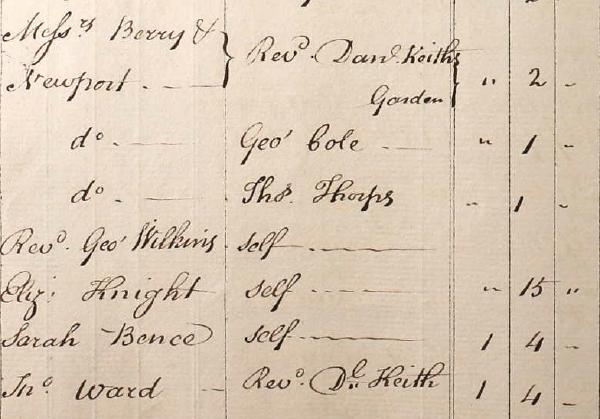 Land tax record for 1798 |
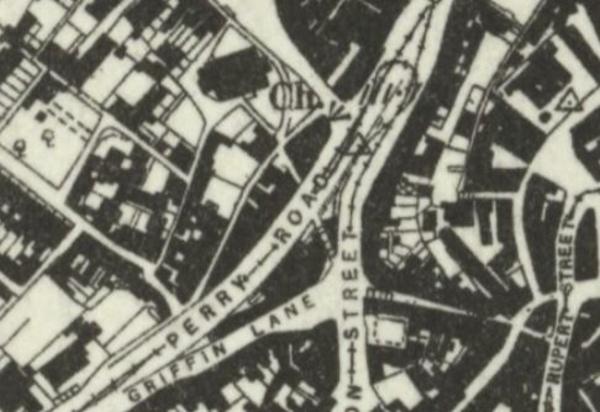 Lower Church St in 1883, running below the CH (=St Michael's Church) |
 Similar area today |
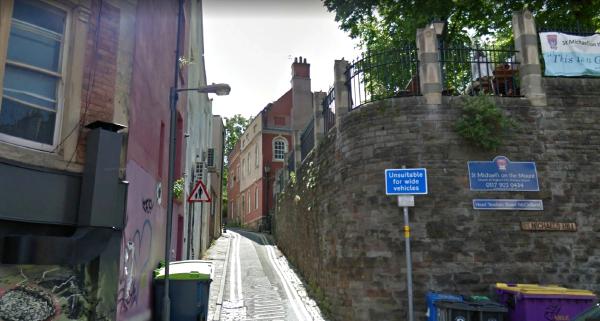 Church
Lane today with the Church of St Michael Without Church
Lane today with the Church of St Michael Without |
The Rectory House, Kelston
Daniel did not stay at Church Lane, Bristol for long, perhaps 2 years. We do not know why he left but by 30 July 1800 he had found new premises at Kelston, close to Bath. He first advertised for pupils on 30 July 1800 and then a "Good plain cook", for a "gentleman's Family and then a week later for Rev Mr Keith's school. He must have found a cook and some pupils, for the Bath Chronicle reported in the issue of 1 January 1801 that the young gentlemen at Kelson School had collected One Pound 4 shillings to be distributed to the poor at Christmas. He also advertised for new pupils in January 1801 and 22 July 1802.
Kelston a small hamlet part-way between Bristol and Bath. Daniel was now living in the Rectory House at Kelston and running a school from the house.
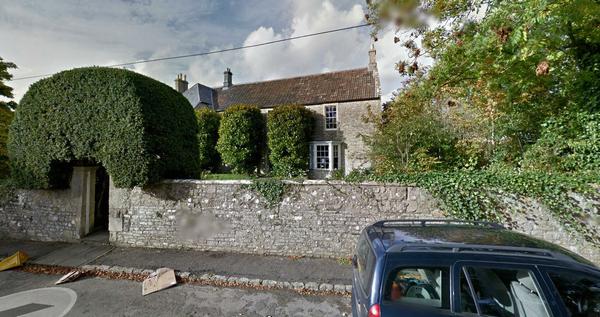 Kelston Rectory today
Kelston Rectory today |
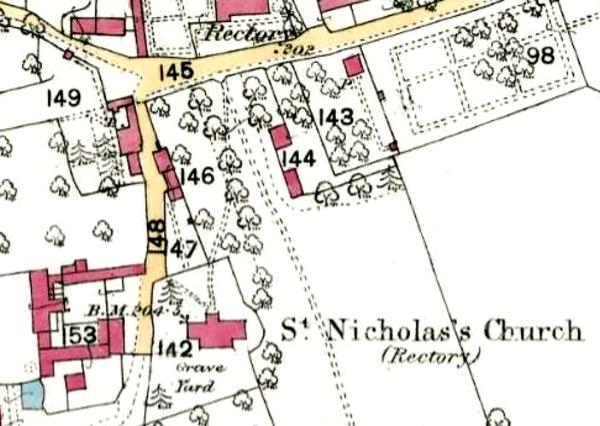 Kelston Rectory House and church identified in the 1883 map  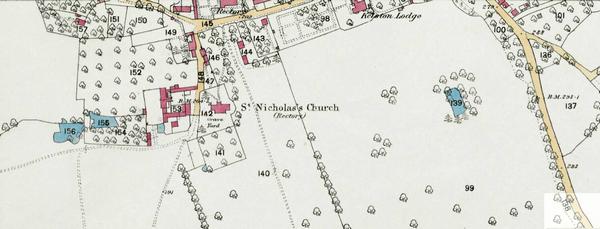 More of Kelston on the 1883 map  Similar view of Kelston today |
Another new school: Summer Hill House, St George, Bristol
The next record we have is when his first son - Edward Joseph KEITH - was christened on 16 May 1802 at Kelston (see below for image). This venue was also short-lived as by late 1803 Daniel had found new premises for his school at Summer Hill, St George, Bristol. A Bristol newspaper reported he had found new premises for his school at Summer Hill as he had been removed from the Rectory House as a consequence of the Clergy Residence Bill. This newspaper article explains the move.
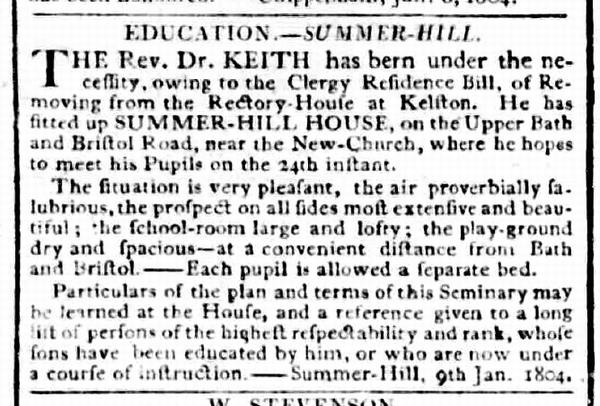 Bath Chronicle 12 January 1804 |
 Bristol Times & Mirror 28 January 1804 |
 Bath Chronicle 10 January 1805 |
 Bath Journal 14 January 1805 |
Where was the school at Summer Hill?
Summerhill (or Summer Hill or Somer Hill) is now part of Bristol, the city having grown out to engulf the area. The location of Summerhill has changed considerably since 1804. All of the early buildings have been demolished; even the "New Church" of St George and it's associated vicarage have gone and been replaced by apartment blocks and rows of cheap houses. Early maps of Summerhill show the location of "Summerhill House" on a triangular block bordered by the Bath Rd, Clovelly and Marling Roads, lying a little to the east of St George Church. However, this is NOT the location of Daniel Keith's school.
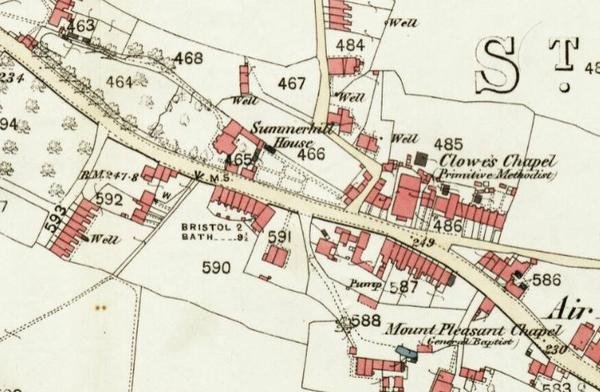 Summerhill in 1883 showing the location of Summerhill House. This is not the location of Daniel's school |
In his 1804 advertisements for the school Daniel tells us it was "on the Upper Bath to Bristol Road, near the New-Church". Later, in 1810 it was desribed as "about 2 acres" and "nearly opposite the New Church". The local history society - The Friends of Troopers Hill - has published an excellent account of Summerhill House St George - A Tale of Two Houses (download the article in PDF format here). The location of Daniel's school is identifed as Lot 1060 on the 1840 Tithe Map as shown here.
 The 1840 Tithe Map for St George, identifying the "New Church" of St George and Lot 1060, being Daniel Keith's school. The property was desribed as "nearly 2 Acres so probably included Lot 1059. (Click on map for larger version.) |
 Same location in mid-1800s. The school is now identifed "School (Boys & Girls)" |
 Same location in 1900s. The school has been replaced with houses. |
 Same location in 2016. The Church and Vicarage have gone. (Images from Bristol City Council map collection. See Bristol Archives catalogue reference here and the actual Tithe Map here |
Summerhill School - the patronising views of William Stanigar
William Thomas Sanigar was a noted local historian. He was born in 1882 and died in 1959. He wrote many booklets on the history of Bristol, including "Houses and People of Old St George". Here, he describes the history of Summer Hill School, beginning with the "Rev. D. Keith A.M. (often styled Dr Keith), who had a somewhat chequered career flitting about from place to place establishing and abandoning schools". (!)
 |
 |
 |
 |
 |
 |
 |
 |
 |
 |
 |
Images from Internet Archive see document here Or, download the full document in PDF format here. |
From Bristol to Hammersmith, London
A new school at Kent House, Lower Mall, Hammersmith
Daniel built up his new school at Summerhill, but within four years he was looking further afield for a new and grander location. In mid-1808 he appears to have taken the copyhold (lease) on a grand property facing the River Thames, on the Lower Mall, Hammersmith. He renamed the property "Kent House" after his benefactor the Duke of Kent. The large house remains there today.
According to his Will, Daniel was awarded the copyhold on Kent House on 7 October 1808. He was in residence by April 1809 (see letter from Duke of Kent below). A property matching the description of Kent House was advertised in London papers in April 1808:
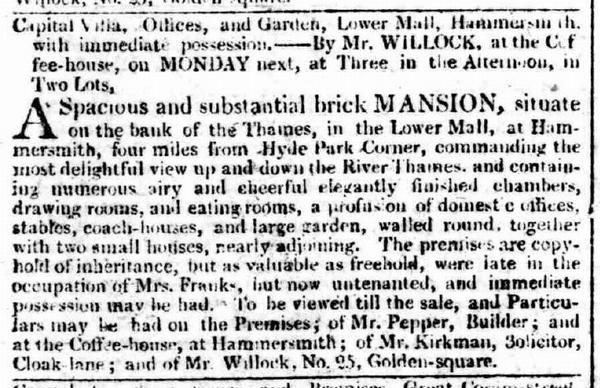 Morning Advertiser 23 April 1808 |
Daniel and Jane then set about moving their family to London and establishing a new seminary for young boys on the Lower Mall, Hammersmith. At about this time Jane gave birth to their last child - Jessica Amelia, but as she was not baptised we do not know the exact date. It appears that Daniel continued to run the school at Summerhill after acquiring Kent House, but this would have been possible as he was employing other teaching staff at Summerhill. By early 1810 Daniel was advertising the new school in the London papers. The school was to open on 1 February 1810. The advertisements are illuminating, for the cost of educaton and the list of important people who would vouch for him, the foremost being the Duke of Kent. The cost of 60 Guineas is about £6,500 today. Pupils were prepared for Woolwich (The Royal Military Academy), Eton and the Universities in Scotland (of which Daniel had first-hand knowledge).
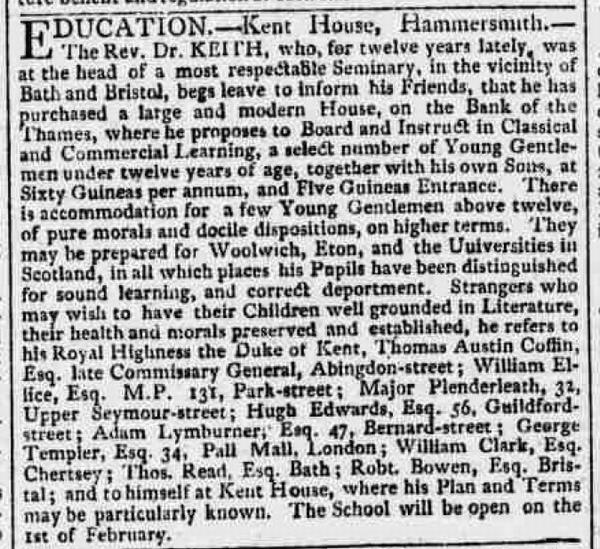 Morning Chronicle 2 February 1810. The cost of education was 60 Guineas or about £6,500 today (plus £510 for entrance). |
The Mansion House becomes Kent House
Kent House, at No. 10 Lower Mall, is an imposing and prominent structure adjacent to the Thames on the Lower Mall at Hammersmith. It was built in 1762 in the Georgian style, extended late in the 1790s and again in 1912. There is more information about the building here. It was originally named the Mansion House but Daniel renamed it Kent House in honour of the Duke of Kent. In his 1839 "History of the Parish of Hammersmith" (which can be viewed online) Faulkner gave a description of Kent House and commented that it was being run as a seminary.
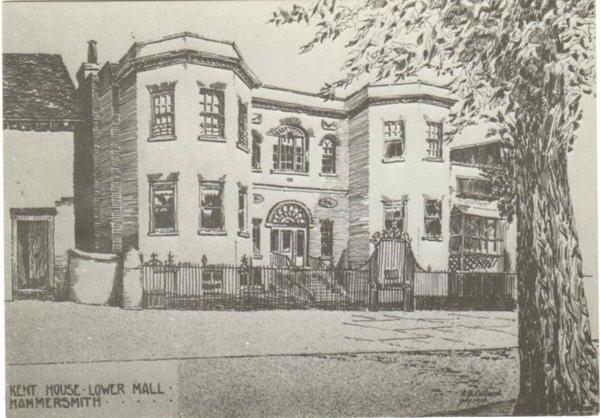 Kent House, 1915. Pencil sketch by Dr John Collard, postcard from Fulham and Hammersmith Historical Society, 1975 |
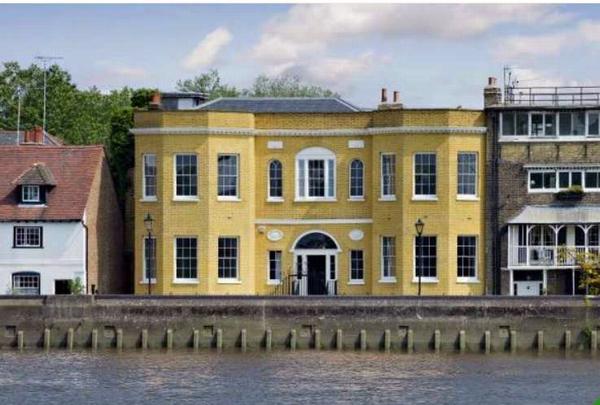 Kent House today |
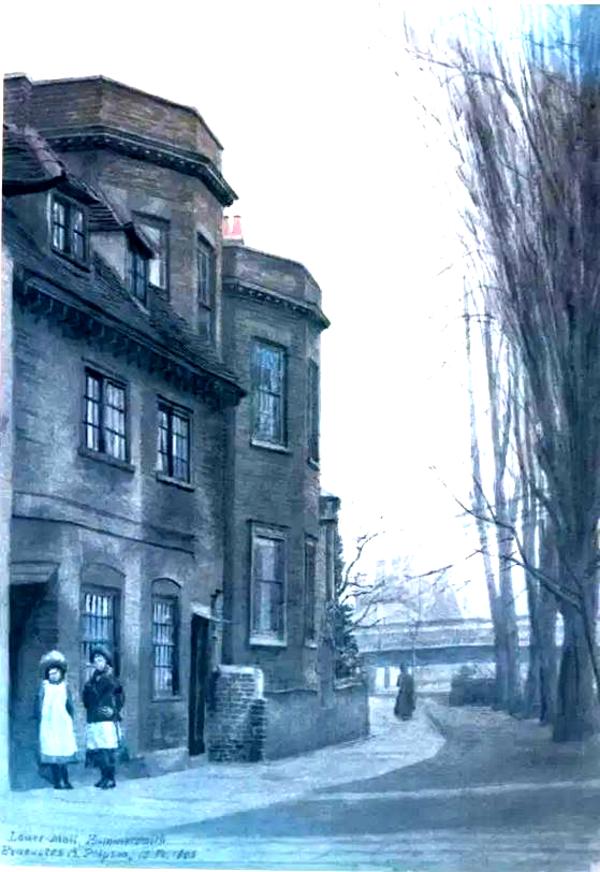 Lower Mall with Kent House, 1905. Watercolour by E.A. Phipson |
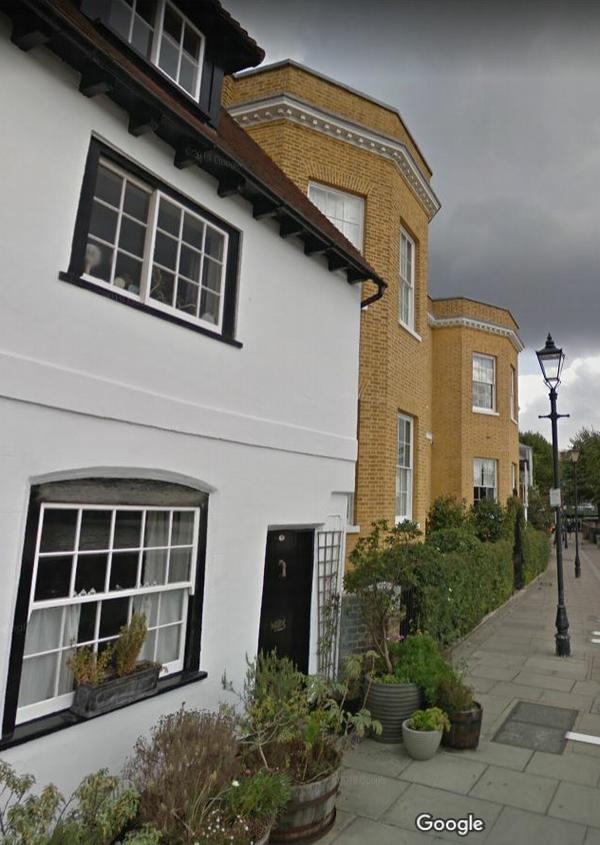 Similar view of the Lower Mall today |
 View across the Thames to Kent House. |
 |
 Kent House in 2023. |
 |
 |
 |
Disposal of Summherhill House in Bristol
Presumably Daniel found a ready market amongst London society for his new seminary. He no longer had a need for the premises in Bristol so he advertised them for sale in 1810. Note that the premises were available for immediate possession, implying Daniel had closed the school there by that date. However, the copyhold did not sell, leaving Jane to deal with it after Daniel's death in 1811 (see below).
Daniel also sold all the furniture in the property. The advertisement gives us an insight to the size of the school: 22 half-tester beds, 22 millpuff beds; four-post and field bedsteads, feather beds, mattresses etc. Apparently, Daniel did not take these to London for his new school at Hammersmith. Perhaps the cost of transport from Bristol to London was too high, or perhaps he purchased new, better quality furniture in London.
 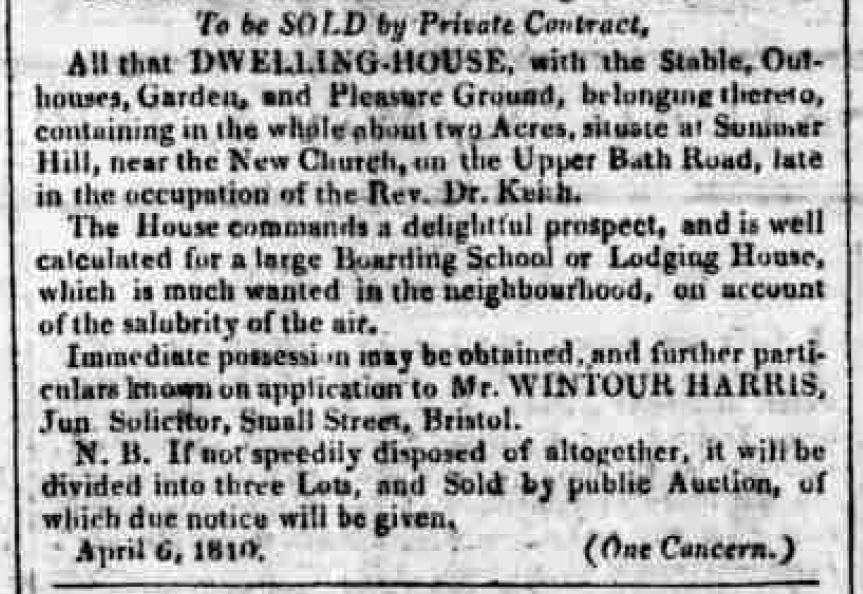 Bristol Mirror 5 May 1810 |
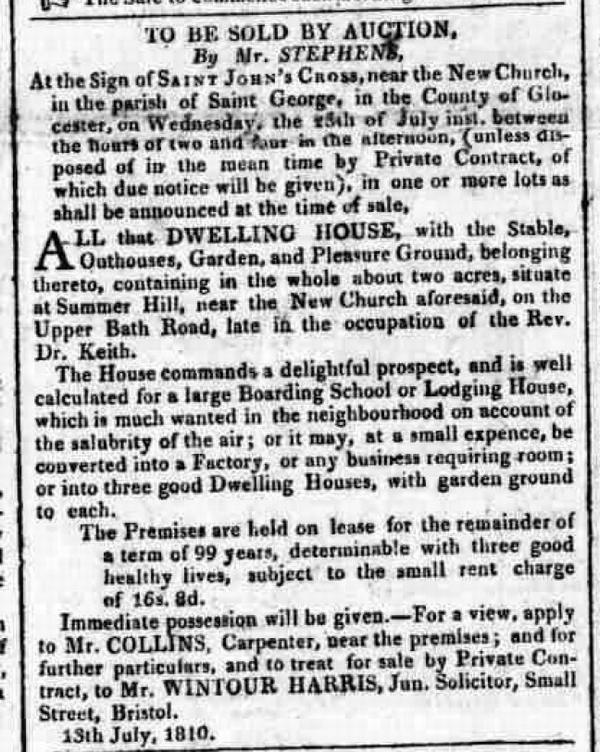 Bristol Mirror 14 July 1810 |
Award of the Honorary Degree - Doctor in Divinity
Returning to St Andrews: Application for the degree of Doctor in Divinity - 1809
By early 1809 Daniel had bought the copyhold on The Mansion House in Hammersmith, renamed it Kent House and begun to set up his new seminary for young gentlemen. He was well regarded as the Rev. Daniel Keith but there was more he could do to win the patriotism of the London elite. So in early 1809 he wrote to St Andrews University to make application for the honorary degree of Doctor in Divinity. He also wrote to the Duke of Kent seeking his endorsement, which was graciously provided.
Attestation by the Duke of Kent on behalf of Daniel KEITH
In support of his application for the awarding of the degree of Doctor in Divinity, Daniel KEITH asked the Duke of Kent for an attestation. The full letter, including packaging (today we would use an envelope) is in the university's archive. The Duke's letter was posted to Daniel at "Kent House, Hammersmith" and is dated 13 January 1809. The letter from the Duke of Kent and Strathearn is interesting. The Duke - otherwise The Prince Edward - was the fourth son of George III, King of Great Britain. He was also the father of Queen Victoria (Prince Edward was next in line for the throne, his older brothers having died young without heirs, but Edward also died before George III so his only surviving child became monarch). The Duke had spent some of his earlier life in Canada, including around two years in Quebec, so met Daniel Keith and knew of his teaching and preaching activities in Quebec.
Transcript from the Minute Book, Scots Presbytery, London
Awarding of the Degree
According to the letter written by the University's librarian in 1907, on 14 February 1809 the University unamimously agreed to confer the Degree of Doctor in Divinity on the Rev Daniel KEITH and and directed the Diploma to be transmitted to his Royal Highness. A copy of the certificate was to be transmitted to the Rev. Dr Daniel Keith. One must presume that Daniel met with the Duke to receive his Diploma. We have no information on the current location of the Diploma, but the Rev. John Godden wrote in 1901 that it was in his possession in Canada.
 |
 |
Daniel was now the Reverend Doctor Daniel Keith.
Further correspondence with St Andrews regarding Rev Dr Daniel KEITH
Although Daniel had now ended his association with St Andrews University his legacy there continued. In 1901 the University received two letters in the St Andrews University library show, it was also confusing for Daniel Keith's grandchildren. The University Librarian received two letters in 1901 both asking for information about Daniel Keith's identity. These two people lived on opposite sides of the world - Niagara in Canada and Adelaide in Australia, showing how far Daniel's family had spread.
Correspondence from the Rev J.K. GODDEN
In May 1901 the Registrar of St Andrews University received a letter from a Rev J.K. (John Keith) GODDEN enquiring about his great-grandfather the Rev Daniel KEITH D.D. The Rev GODDEN was the grandson of Daniel's oldest daughter - Mary - who, as a widow, had married John BLACKWOOD in Montreal in 1831. Their daughter Margaret Henrietta had married the Rev Thomas GODDEN, with the Rev John GODDEN being their son.
Attached to Godden's letter in the St Andrews archives is a note (in shorthand) presumably summarising what information the university could find. There is no record of the letter sent to Rev. Godden.
A letter from a Miss Alice Frances Keith SHERIDAN
Remarkably, a few months later, on 18 October 1901 the University received a letter in her inimitable writing style from Miss Keith SHERIDAN, whose address at the time was 12 Cambridge Terrace, Hyde Park, London. She was asking for information about her grandfather, the late Rev Daniel Keith D.D. of St Andrews University. Miss Alice Frances SHERIDAN (she added the Keith name later) was the daughter of Frances (Fanny) KEITH and John SHERIDAN. She had lived in Adelaide, Australia most of her life.
Reply from St Andrews University
On receiving this reply Miss Keith Sheridan must have been both pleased and surprised. Daniel was awarded an "Honorary" degree, not one awared by examination, their family name was originally "McKIECH" not Keith AND she had a relative (first cousin once-removed) living in Canad and also interested in Daniel Keith. So Miss Sheridan immediately replied the J.Maitland Anderson.
Reply from St Andrews University
Miss Keith Sheridan then replied again:
Reply from St Andrews University
A further reply from St Andrews University
Miss Keith Sheridan had travelled to Britain with her sister Violet some time in early 1901. By that time Violet had married Alfred Mueller SIMPSON, a widower with three young daughters. The "party" Miss Sheridan refers to in her letters to St Andrews consisted of herself, Mr and Mrs Simpson and the three daughters. From various notes and letters in the Sheridan/Simpson collection in Adelaide it appears the party visited England, Scotland, Canada (to visit the Niagara Falls) and Naples on their way home. The homeward journey was on the RMS Ophir, that had left London on 10 February 1902. The Sheridan party boarded the ship in Naples.
 Mr & Mrs SIMPSON and their three daughters, together with Miss Keith Simpson travelling from Naples to Sydney on HMS Ophir, 10 Feb 1902. |
The Family of Daniel and Jane KEITH
It is convenient to pause here and look at the children of Daniel and Jane KEITH.
Daniel and Jane were married in Quebec in 1794. They appear to have had at least two children in Quebec before moving to Bristol - Isabella born in 1796 and Mary born in 1797. As neither child appears to have been baptised there is no direct evidence to hand that shows they were actually born in Canada. However, Mary later married John Blackwood (see Mary's story) in Canada, and she is recorded in the 1901 census for Canada when she gave her place of birth as Quebec. Susan was probably born in Bristol, or on the ship from Canada to England. Either way, it is unusual that Daniel did not take the opportunity to have her baptised in Kelston at the same time as his son Edward Joseph. (But note that only 1 of the 5 girls appears to have been baptised in a church.)
The christening of Edward Joseph KEITH was recorded on 16 May 1802 at the parish church at Kelston. The entry in the Parish Register is intriguing. It states "Edward Joseph son of the Rev Daniel & Jane Keith born May 2nd 1801 was christened". Most other entries in this register are for baptisms and do not give the date of birth, but it was common for ministers to record the date of birth if it was more than a few weeks before the baptism. The year is overwritten and smudged. It appears the Minister wrote 1802 and then changed this to 1801.
Although Daniel was an ordained Presbyterian Minister he was in fact occupying the Kelston Rectory House where he ran his school, so it is most unlikely that he was not welcome in the Church of England. It is noteworthy that in each case the children were almost a year old before they were christened or baptised. Christenings or baptisms were usually conducted a few days to a few weeks after birth. This pattern of late baptism continued with the other children for whom we can find baptism records.
Daniel and Jane went on to have five more children, giving nine in total that we can be sure of.
| Name | Birth/Baptism | Date of Death/Burial |
|---|---|---|
| Isabella | b. 1796, Quebec | bur. 25 Jan 1811 Hammersmith |
| Mary | b. 1797, Quebec | 10 Mar 1874 Montreal |
| Susan | b. c.1799, probably Bristol | 21 Nov 1852, St Clements Dane, London. |
| Edward Joseph | b. 2 May 1801 Christened 16 May 1802, Kelston. |
29 May 1837 Sydney Australia |
| James George Bowen | b. 23 Dec 1802 Bap. 4 Dec 1803, Kelston |
bur. 16 Jan 1811 Hammersmith |
| Robert | b. 22 April 1804 | bur 3 May 1804 St George, Bristol |
| Thomas Davis | b. 5 Aug 1805 Bristol Bap. 26 March 1806, St George, Bristol. |
? |
| Frances Jane Avice (Fanny) | b. 16 May 1806 bap. 19 Aug 1807 St George, Bristol |
14 January 1882, Adelaide, Australia |
| Jessica Amelia | b. 1809 | 10 Dec 1852, Sydney Australia |
Baptismal records
It is unusual that all the males were baptised but only one of the five females. We can only assume that Daniel, as an ordained minister, performed the baptisms at home.Given his religious background, it is highly unlikely that any of his children were not baptised. Of course the baptism did not have to be in a recognised church, or performed by a minister attached to a church.
 |
 |
 |
 |
 |
Family tragedy - Death of two children followed by Daniel
By early 1810 Daniel, Jane and eight children were living at Kent House, Lower Mall, Hammersmith. Daniel was now the Rev. Dr. KEITH and had a thriving seminary for young gentlemen. After his earlier years of difficulty and loss in Quebec and hard work in Bristla and Bath he must have had an air of accomplishment. His future was secure.
But, in the space of a few weeks in January and February 1811 two of Daniel's children died - James George on 16 Jan and his oldest daughter Isabella on 26 Jan. The cause of death appears to have been scarlet fever brought into the school by a pupil. tragically, 20 days later Daniel himself died on 15 February 1811. All three were buried at St Pauls, Hammersmith. Today, nothing remains of the burial grounds attached to the church.
One of the parish register books available on line for St Pauls, Hammersmith is actually a notebook relating to burials in the church. Many of the entries indicate where in the churchyard the burial occured, the name of the undertaker and a guess at the cause of death. The scribe was a poor speller ("died" for instance is spelled "dide"). The entry for Daniel KEITH states the cause of death was "parlaltick Strock". Taken phonetically this is "paralytic stroke or shock". This may be a consequence of Scarlet Fever, but more likely was caused by a brain aneurysm or heart attack.
 A burial notebook for St Pauls, Hammersmith, with a cryptic reference to the cause of death for Daniel - "Paralytic Shock" perhaps? |
Daniel's Will
Daniel left a Will. This was unusual in 1811 unless the person had significant money and land. We do not know the value of the estate but it would have been over £20 as it attracted Death Duties. Note that the Will is the only original record we have acknowledging that Daniel had been awarded the degree of Doctor of Divinity.
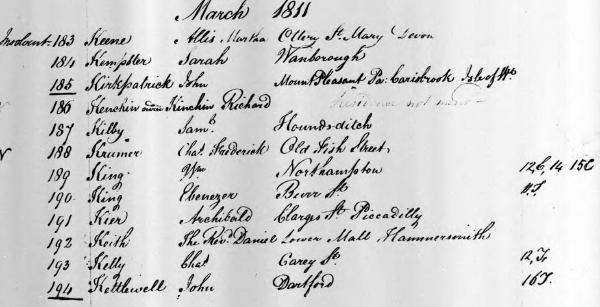 Entry
in Death Duty register Entry
in Death Duty register |
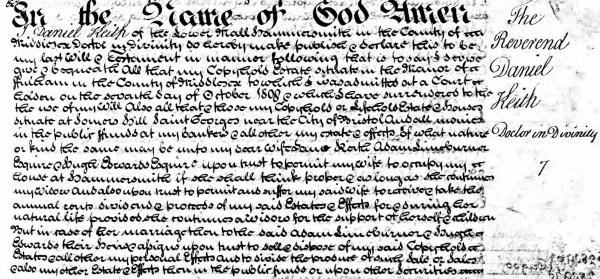 Will of
Daniel Keith Page 1 Will of
Daniel Keith Page 1 |
 Will Page
2 Will Page
2 |
The Will is difficult to read in places but it leaves his estate to his "dear wife Jane Keith" comprising the "copyhold estate in the Manor of Fulham, Middlesex to which I was admitted by a Court holden on the seventh day of October 1808" also "my copyhold or lifehold estate & houses situate at Somers Hill St Georges near the city of Bristol". He leaves all this in trust "to permit my wife to occupy my house at Hammersmith if she shall think proper and as long as she remains my widow". It also appoints two trustees to manage the estate and to provide for any children that may be alive until they reach the age of twenty-one years and then to transfer the estate to these children within six months of the death or marriage of Jane.
The Will refers to two "Copyhold" estates, one in the Manor of Fulham, Middlesex and the other at Somers Hill (Summers Hill) St George, Bristol. Rights to the former "to which I was granted by a Court holden on 7th October 1808". Copyhold was an ancient form of customary land tenure whereby occupation rights to land owned by the local Lord of the Manor was granted to a person in return for a specified service or payment. In the 1850s this service was converted to a rent. The agreement was entered into the Manor Book or Roll and a copy was provided to the tenant - hence "copy hold". Copyhold passed down through the family as of right and did not need to be specified in a Will or change of agreement with the Lord (as compared to Lifehold which was only for the life of the tenant). Copyholds could be sold by the tenant, usually by the tenant giving the right back to the Lord on the condition that it be transferred to the purchaser. By 1800 there were many advertisements in local newspapers for the sale of copyholds, some noting that the terms and conditions were as favourable as a lease.
Although the Copyhold at Fulham in London was awarded by a Court, as was usual when copyholds were sold, it had been advertised for sale. Daniel would have bought the right from the previous holder. The Bristol copyhold was also probably bought by Daniel rather than being received through a family succession. He established a school, first in Bristol and then in the Rectory House at Kelston, before being evicted and having to find new premises, which he did at Summer Hill, St George.
Daniel had advertised the Summer Hill property for sale in 1810 after his removal to Hammersmith but it did not sell. His trustees offered the property for sale shortly after Daniel's death in April 1811. By this time the property had been subdivided into four lots. These were advertised in April 1811. However it is not clear from the documents that the "summer retreats" were part of the property that included Summerhill House. The school had been taken over by Mr Jones, which he was still running in 1813.
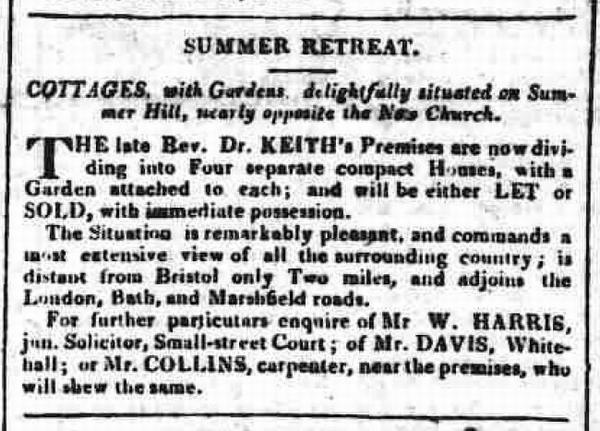 Bristol Mirror 6 April 1811 |
It is not clear that all of the properties sold. Some time after Daniel's death, his widow Jane and family were living at St George, possibly in one of these properties. Jane died there in 1824.
Jane may have stayed on at Kent House and continued teaching the boys at the seminary. But by early the next year she had decided to leave and the property was advertised for sale.
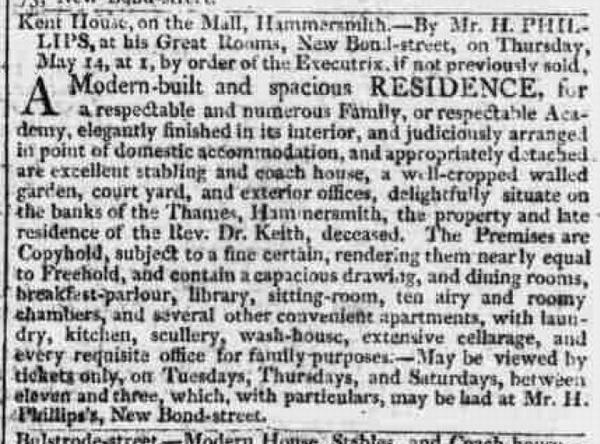 Morning Chronicle 5 May 1812 |
Continuation of the School at Summer Hill
Although Daniel had left Summer Hill and established a new seminary at the Lower Mall Hammersmith, it appears that the school at Summer Hill St George, Bristol continued to operate. It was now run by Mr N.W. JONES. He continued with the school for several years. In November 1813 he advertised for new pupils.
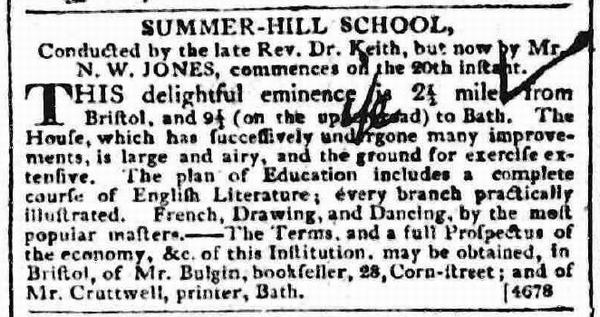 Bath Chronicle 18 November 1813 |
Addition to Daniel's Will
The copy of Daniel's Will has an interesting addition in the left margin. It is hard to read but it is dated 1843 which was 19 years after Jane had died.
"On the 26th June 1843 xx with the Will xx of the goods chattels and credits of the Rev Daniel Keith formerly of Somars (sic) Hill St Georges in the City of Bristol but late of the Lower Mall Hammersmith within the city of Middlesex Doctor of Divinity deceased left unadministered by Jane Keith widower deceased whilst living the Relict so executing one of the xx of legatees by trust xx legatee during life or Widowhood appointed in the said Will was granted to Jessica Amelia Keith spinster one of the natural and lawful children and as such one of the xx legatees subsituted in the said Will having been first sworn duly to administer the said Executrix died intestate and Adam xx and Hugh Edwards esquires the other xx legatees in trust being dead as by Acts of Law appears."
The outcome of this addition was to appoint Jessica Amelia KEITH as the executrix and trustee to Daniel's Will because Jane and the two named trustees had all died. Presumably there was money or property still held in trust.
The Gossipist Mrs Crawford's account of Daniel's Life
Shortly after the death of Daniel's son Edward Joseph KEITH in Sydney in 1837, the local magazine The Colonist, reproduced an article written by Mrs Crawford. There are many errors of fact, especially dates and ages, but the overall story accords well the the evidence.
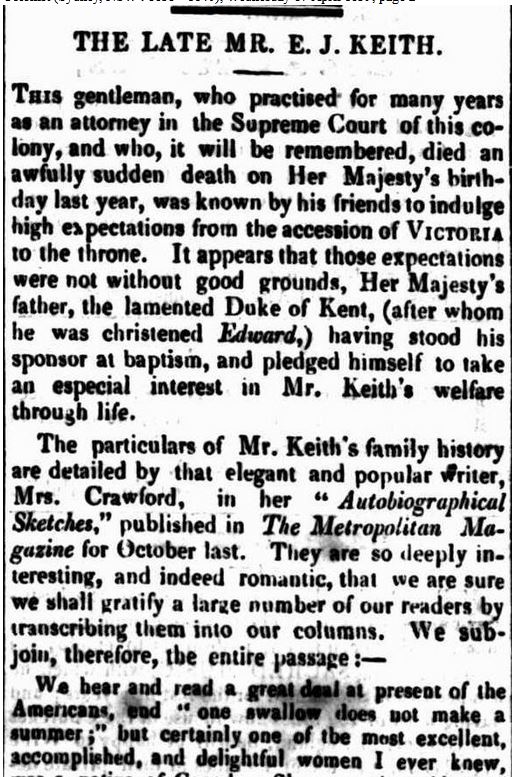 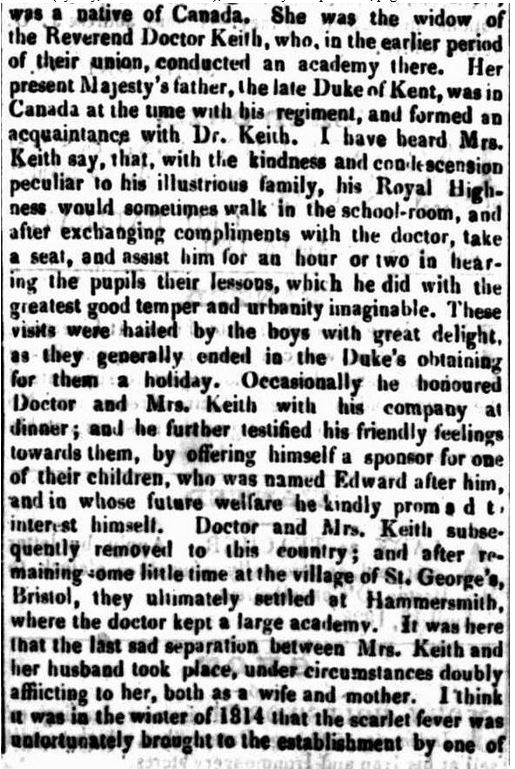 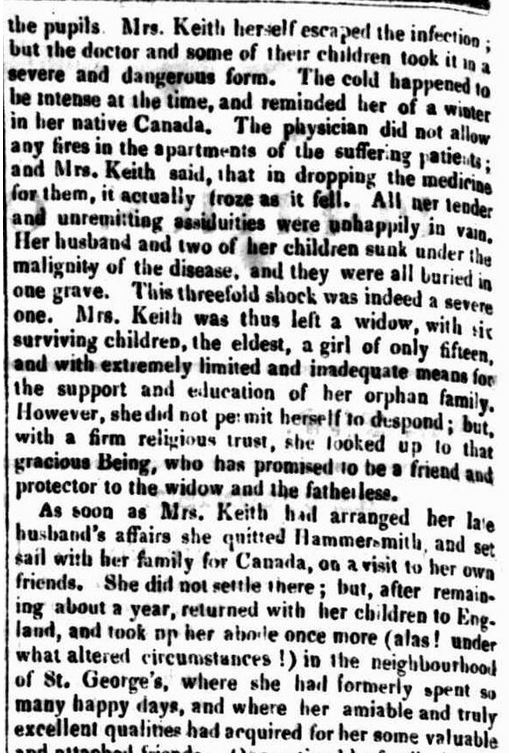 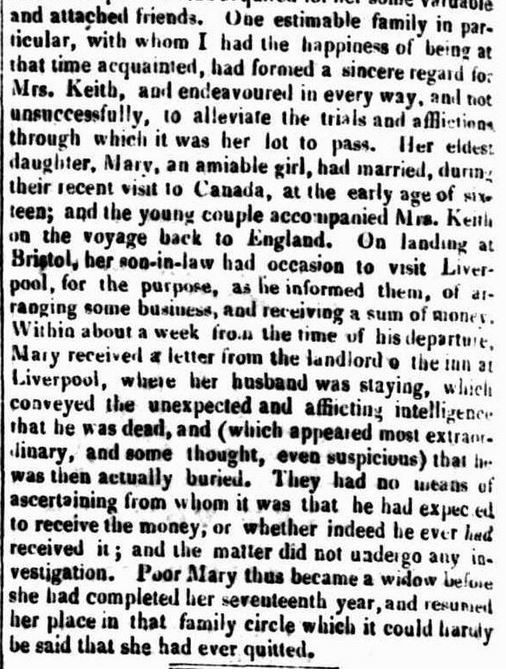 |
What became of Daniel's wife - Jane McPHERSON?
When Daniel died in 1811, his wife was aged 35 and she had six children aged from 2 to 13 years under her care (Mary, Edward Joseph, Susan, Thomas Davis, Frances Jane, and Jessica Amelia). Although Daniel left an estate valued at over £20, Jane may have found life difficult without Daniel's income and without any close family or relations in London. It is unlikely that she continued to run the seminary at Lower Mall, although it does appear to have remained a seminary through to the mid-1800s or later.
In 1816, five years after Daniel had died, Jane took the family back to Quebec to join her family there. A Mrs Keith and family arrived in Quebec, departed London 3 April arrived 29 May 1816 as noted in the Quebec Gazette No. 2680 on 30 May 1816. Mrs Crawford, the gossip columnist wrote that Jane took her six children to Canada after Daniel died. If this is correct, Jane would have taken Mary aged 18, Susan aged 16, Edward aged 15, Thomas 11, Frances aged 9 and Jessica aged 7.
 Quebec Gazette 30 May 1816 |
The next few years are not clearly identified in the records. It appears that Jane and family remained in Quebec for up to six year before Jane KEITH returned to England and lived in Bristol. She may have lived initially on the copyhold land at Summer Hill, St George as mentioned in Daniel's Will. Her daughter Mary with her husband William McNish PORTER (married whilst they were in Canada) also travelled to Bristol, perhaps at the same time, as their daughter Jane PORTER was born in Bristol in 1823 and baptised at St George on 19 June 1823. Edward Joseph is mentioned in the Quebec Gazette for June 1822 when he was admitted to the bar. It is likely he and his sisters Frances, Susan and Jessica would have returned to England with Jane and Mary.
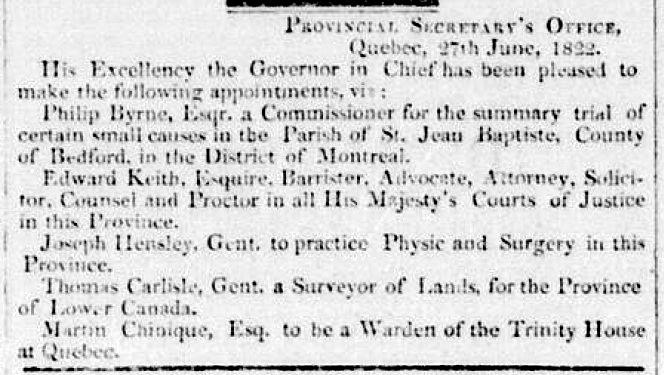 Quebec
Gazette 27 June 1822 Quebec
Gazette 27 June 1822 |
Grand-Mamma's Letter
Amongst the collection of papers held at the State Library in Adelaide is a fragile letter in an envelope that Alice Keith Sheridan has labelled "Grand Mamma's letter. It was written by her grandmother Jane Keith whilst living at Upper Easton, Bristol. The letter is addressed to Fanny, at Mrs (Mary) Porter, Newport (Wales). It is dated Jun 182_. Alice thought perhaps 1822 or 1824 but as Jane died in March 1824 it could only be 1822 or 1823. The letter mentions the teething pains of Jane's young grand-daughter Jane PORTER, who was baptised in St George on 19 June 1823. It also mentions Jane taking the "packet steamer" home (when Fanny got her feet wet). The letter is written on both sides of a small piece of paper and today is difficult to decipher, even though it has been professionally conserved (paid for by a Keith descendent). Fortunately Alice, who was an expert at deciphering writing and foreign languages undertook a transcription. Her version was located elsewhere in the Archives.
 The envelope with Alice's writing |
 Side 1 (click on image to see a large version) Side 1 (click on image to see a large version) |
 Side 2 |
According to Alice, the scraps of letter read as follows (although I am not sure Alice has them all in the correct order):
 |
 |
 |
 |
 |
 |
 |
Page 1 and sweet little Jane Page 2 from the inclemency Page 3 I have not Page 4 I shall defer doing so Miss F. Keith |
Death of Jane KEITH
Jane died on 26 March 1824 with the burial recorded at St George, Bristol. The abode is "Upper Easton", a suburb of Bristol and a short distance to the west of St George. The baptism of Jane PORTER in June 1823 records the same abode. Jane was buried in the churchyard at St George Church, Summerhill. A large headstone was erected but it has not withstood the ravages of time. A photograph of the headstone is contained in the Sheridan Collection at the State Library of South Austalia. It was taken in 1901 by Alice Keith Sheridan and her sister Violet when they visited St George Church on a trip from Adelaide.
The Children of Daniel and Jane KEITH
What happened to the nine children of Daniel and Jane? Follow the links for more information on four of the children.
Isabella was born about 1795 in Quebec. She died at Hammersmith and was bured 26 January 1811, aged 14.
Mary was born about 1796 in Quebec. She returned to Canada with daughter Jane PORTER, married John BLACKWOOD and had three more children, starting a large family of Blackwood and Godden descendents. She died in Montreal on 10 March 1874.
Susan was born about 1798, probaly in Bristol. She accompanied her brother Edward Joseph, his new wife Ann and sisters Frances and Jessica on the voyage to Australia. But Susan jumped ship in Cape Town and married John BEAL, purser on HMS Glendowner that was stationed in Cape Town at the time. She and John returned to England and had one child Sophia Jesse BEAL. It would appear that Susan became estranged from John BEAL and she died in the slums of London on 21 November 1852.
Edward Joseph was born 2 May 1801 in Somerset. He became a lawyer, married Ann McPherson in London in 1825, immediately sailed for Australia where he had four children with Ann and three with his mistress Louisa Hanks. He died in Sydney on 29 May 1837.
James George Bowen was born 23 Decembr 1802. He died at Hammersmith and was buried on 16 January 1811, aged 9.
Robert was born 22 April 1804 at St George, Bristol and died a few weeks after birth on 3 May 1804.
Thomas Davis was born on 5 August 1805 at St George, Bristol 1805 but kept a low profile in the records. He appears to have travelled to Canada in 1826 but has not been found after this.
 |
Frances Jane Avice (Fanny or Jane in some records) was born on 16 May 1807 at St george, Bristol. She was 17 when her mother died in 1824. She accompanied her brother Edward and his new wife to Sydney, Australia where she married Robert MARTIN in 1826. She returned to England with Robert Martin, but then eloped to Pimlico in London with a mad doctor - John SHERIDAN, with whom she had four children. Robert Martin eventually divorced her in 1847 so that he could marry Eliza BARRON. After the divorce John and Frances moved to Adelaide, Australia. She died in Adelaide on 14 Jan 1882. Her daughters Alice and Violet left a large legacy to Adelaide Hospital.
Jessica Amelia was born in 1809 at Hammersmith. She travelled to Australia with her brother Edward. After Edward died she accompanied Edward's widow Ann back to London but returned to Australia with her niece Clara. It appears she never married. She died at the Benevolent Asylum, Melbourne on 10 December 1852 and was buried at St James, Melbourne on 11 December 1852, single, aged 42 years.
 Burial record for Jessica KEITH at St James, County of Bourke, Melbourne, 11 December 1852. |
Return to the Benton Family Index Page
Last updated: 30 July 2025





